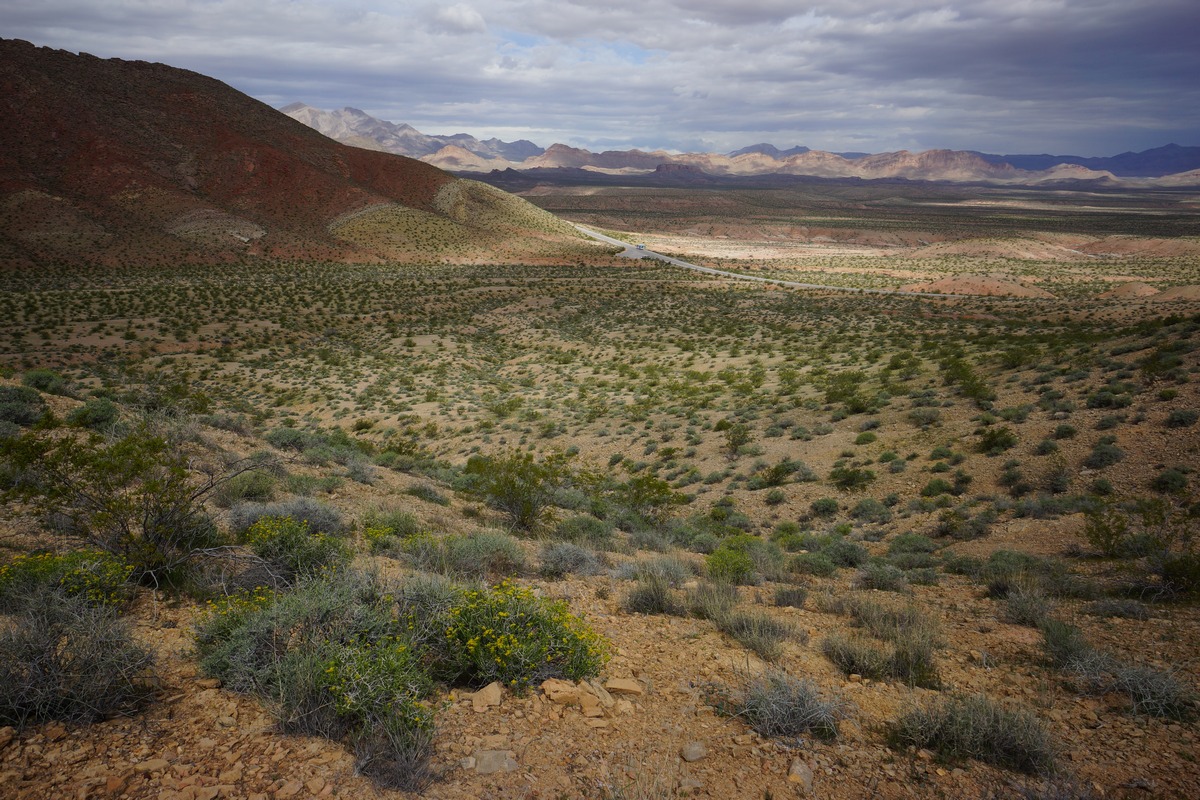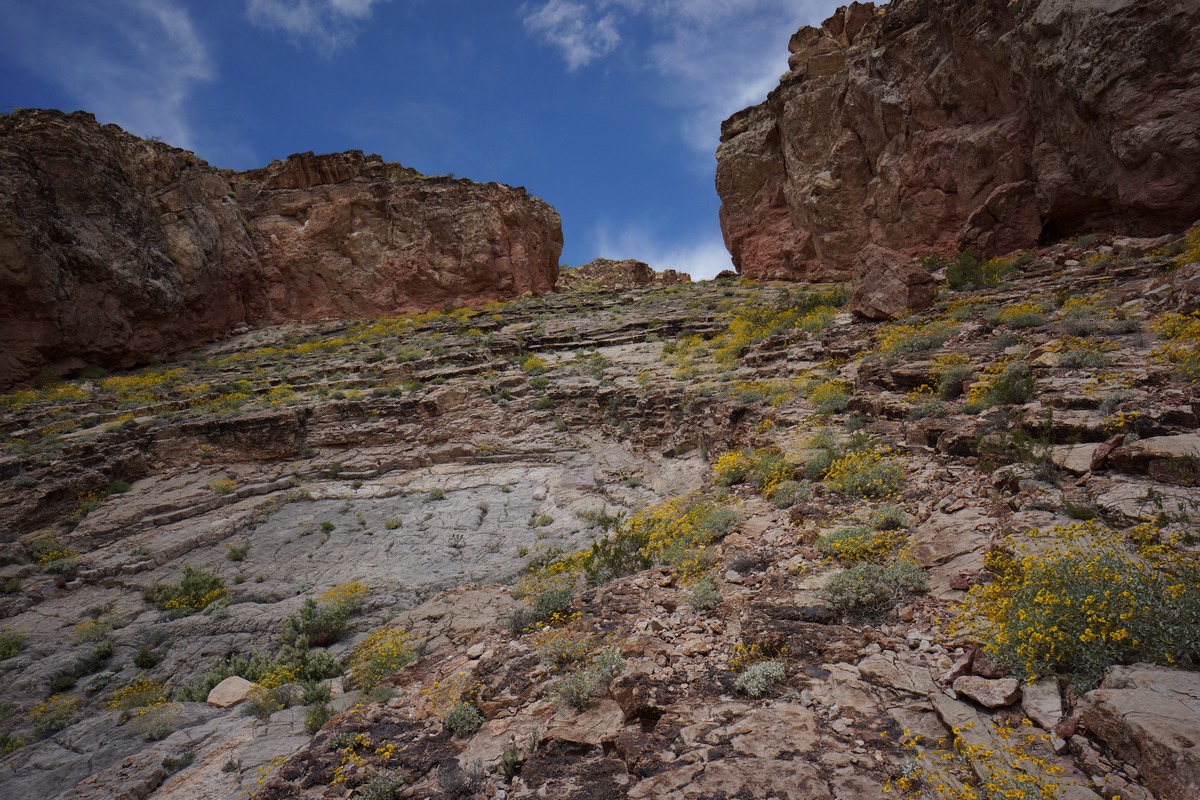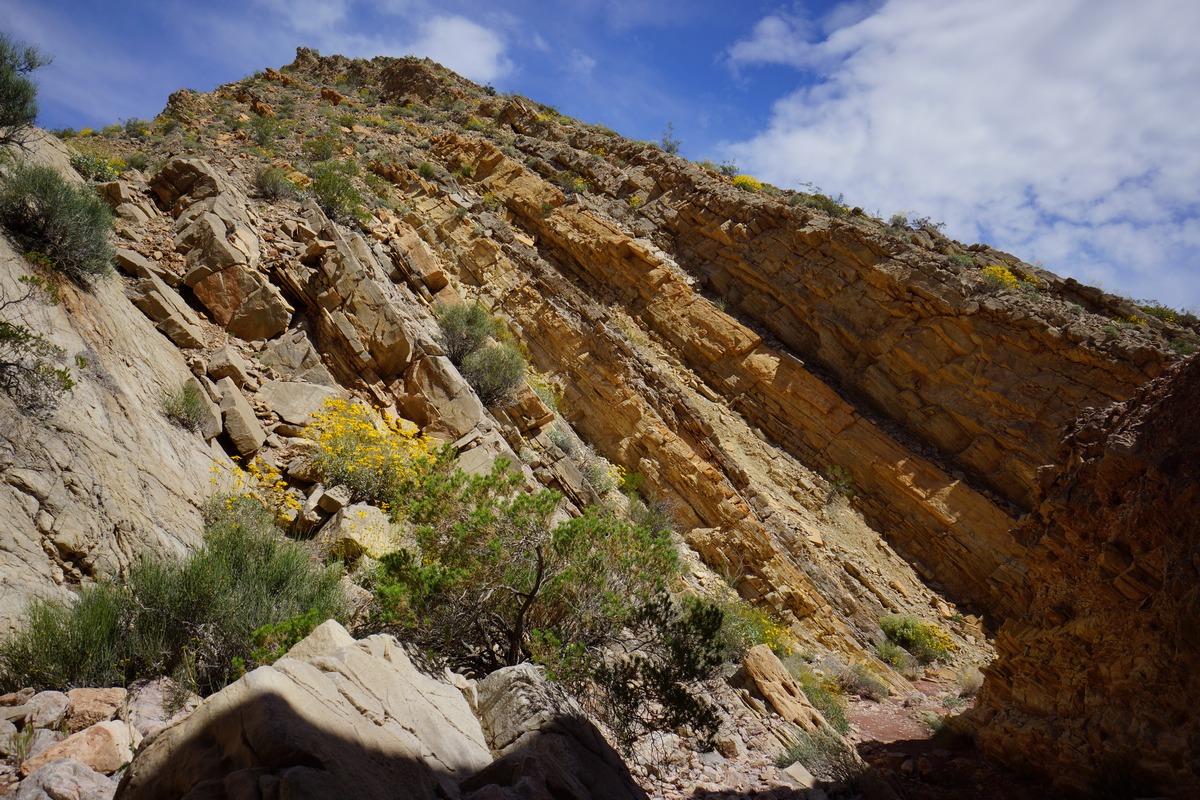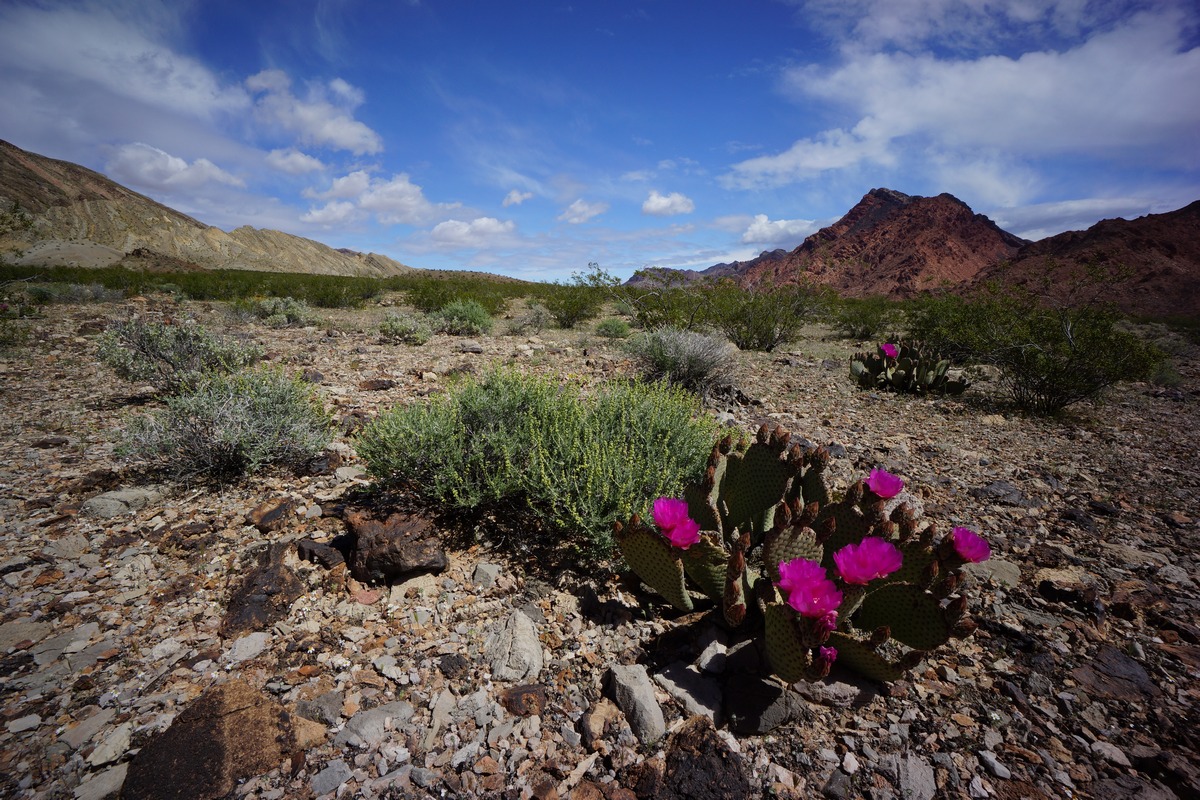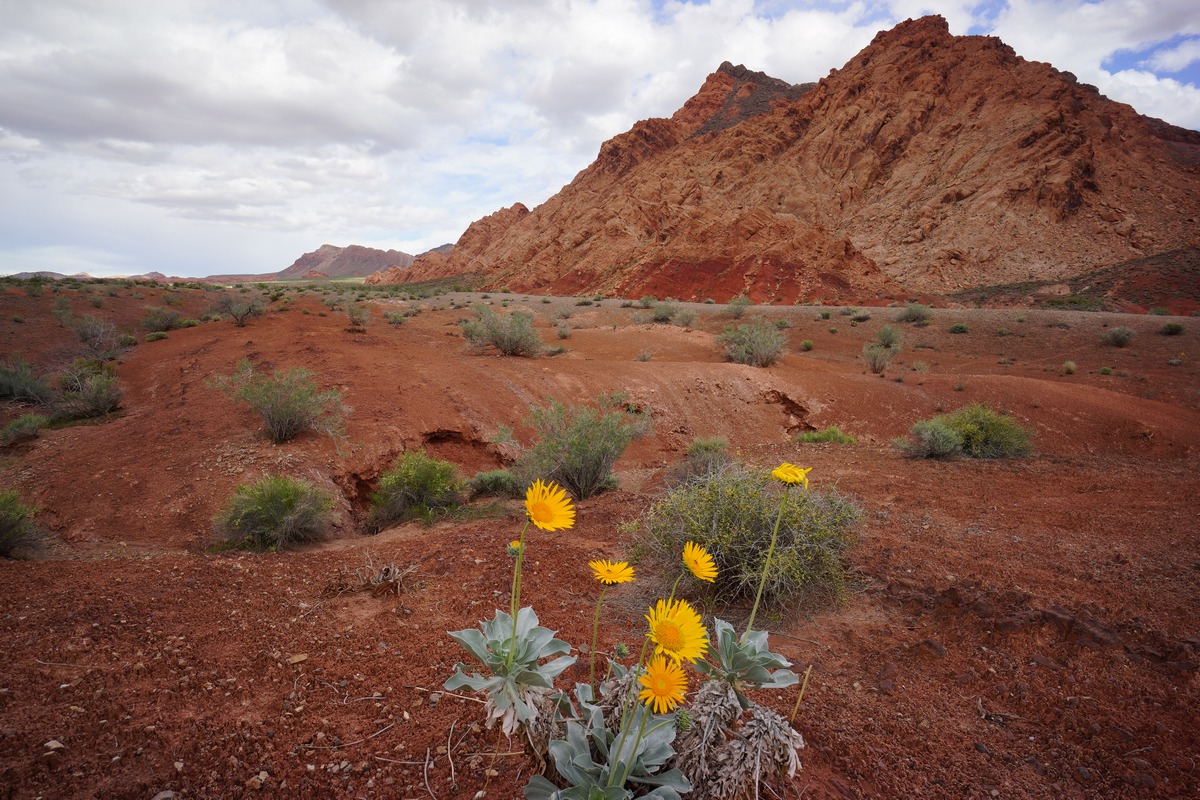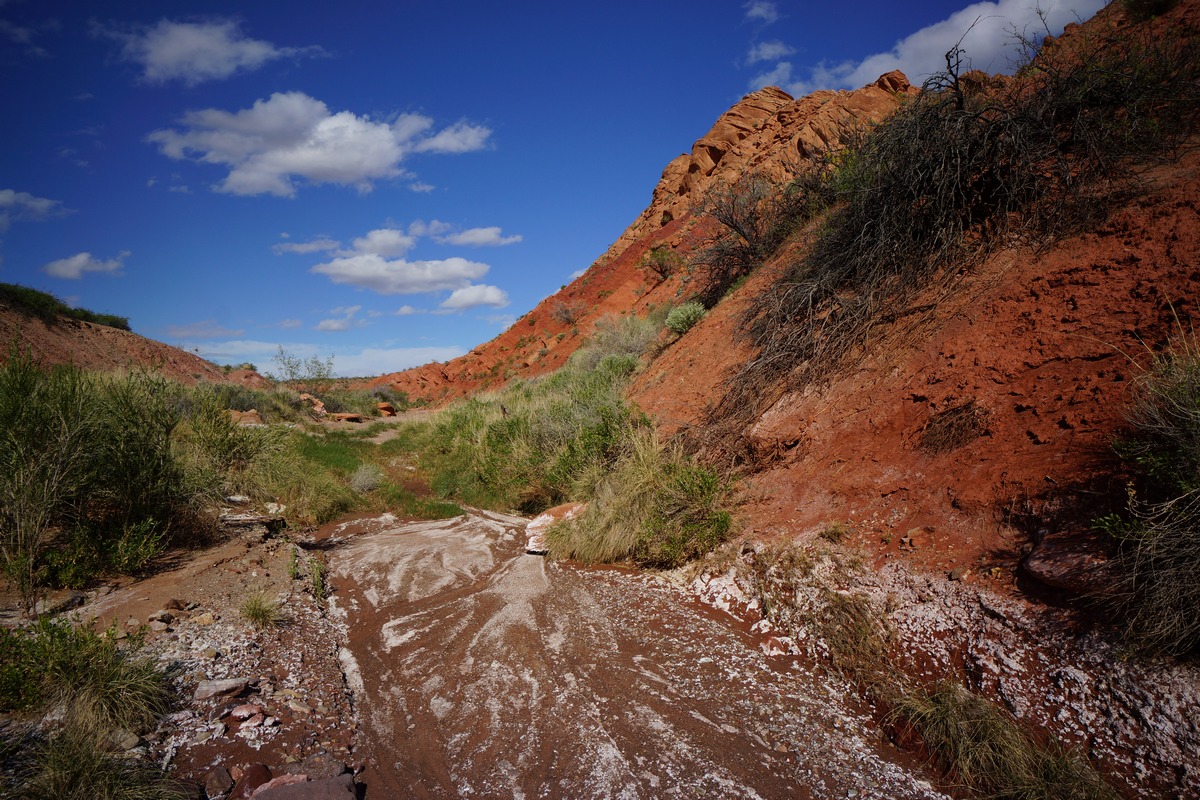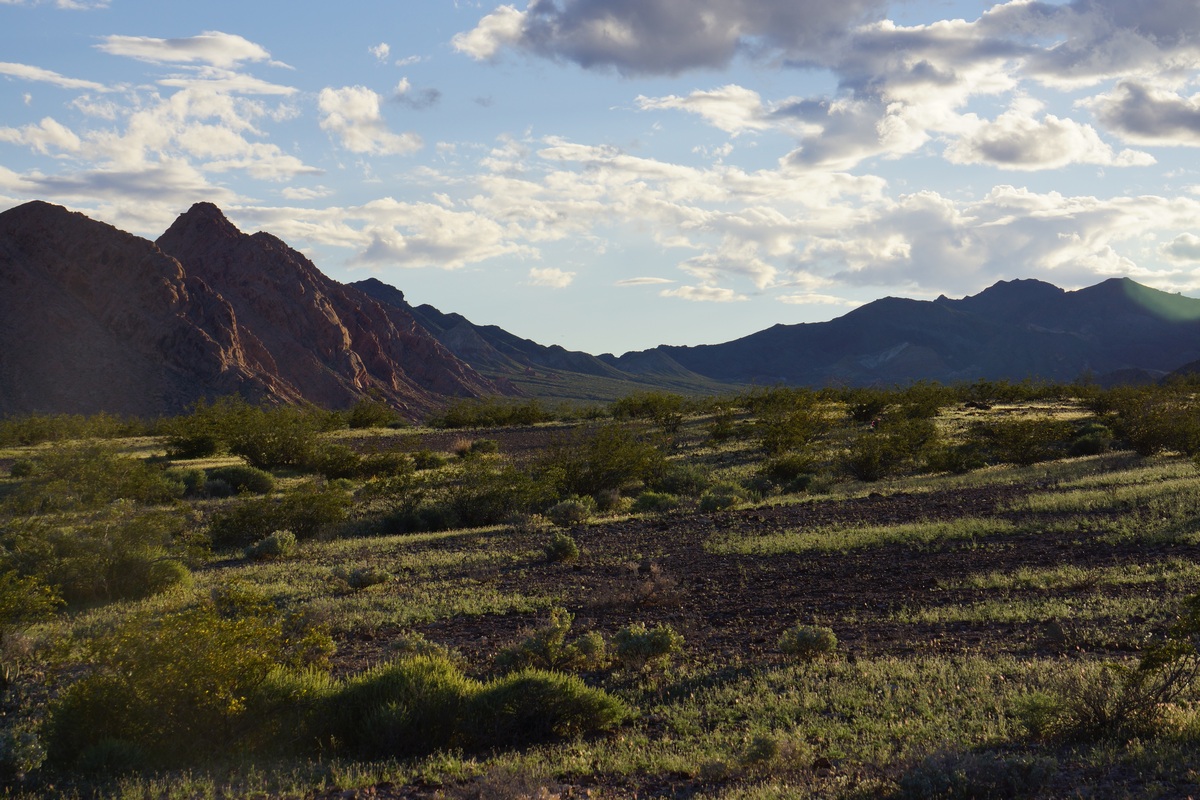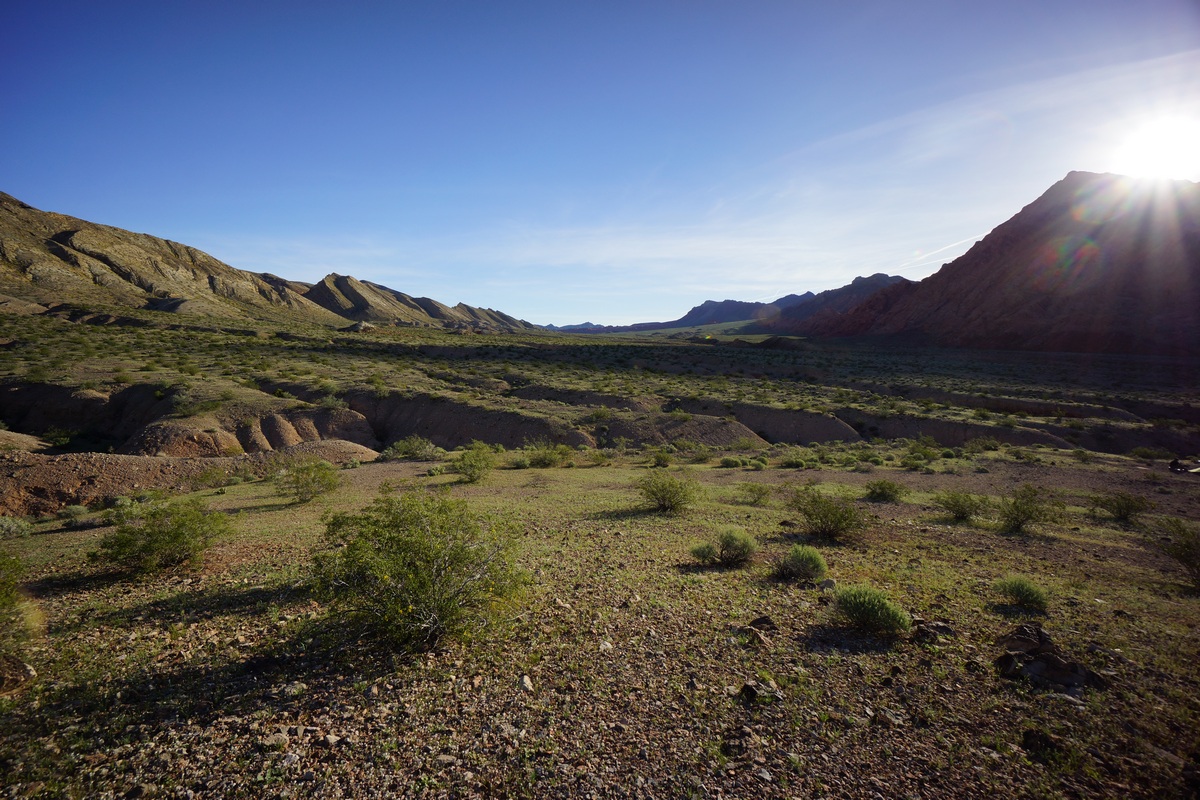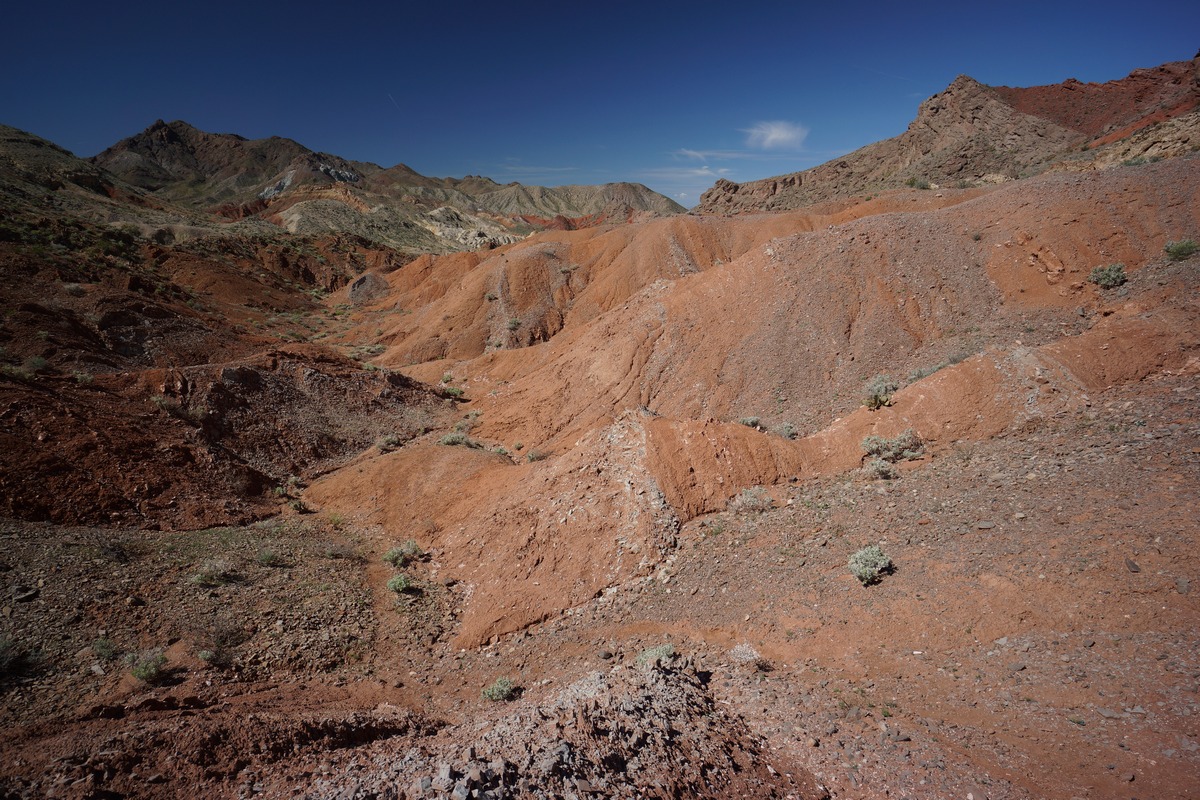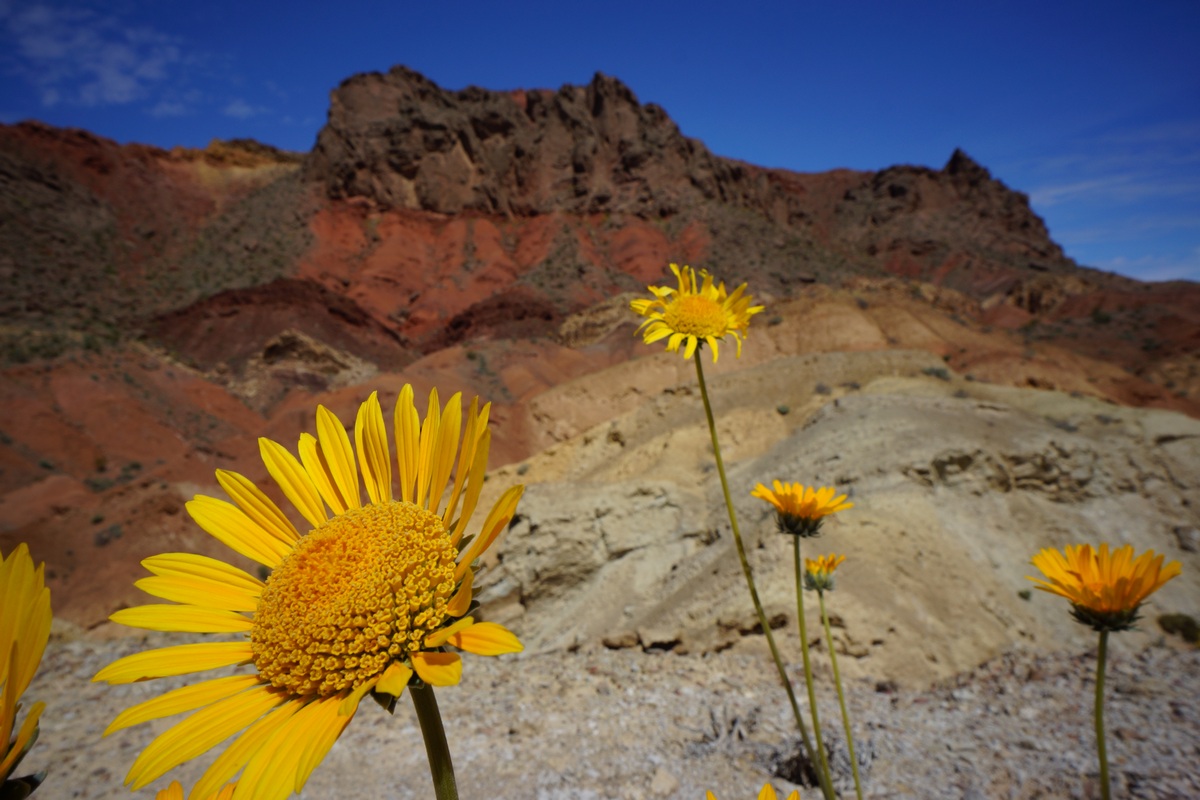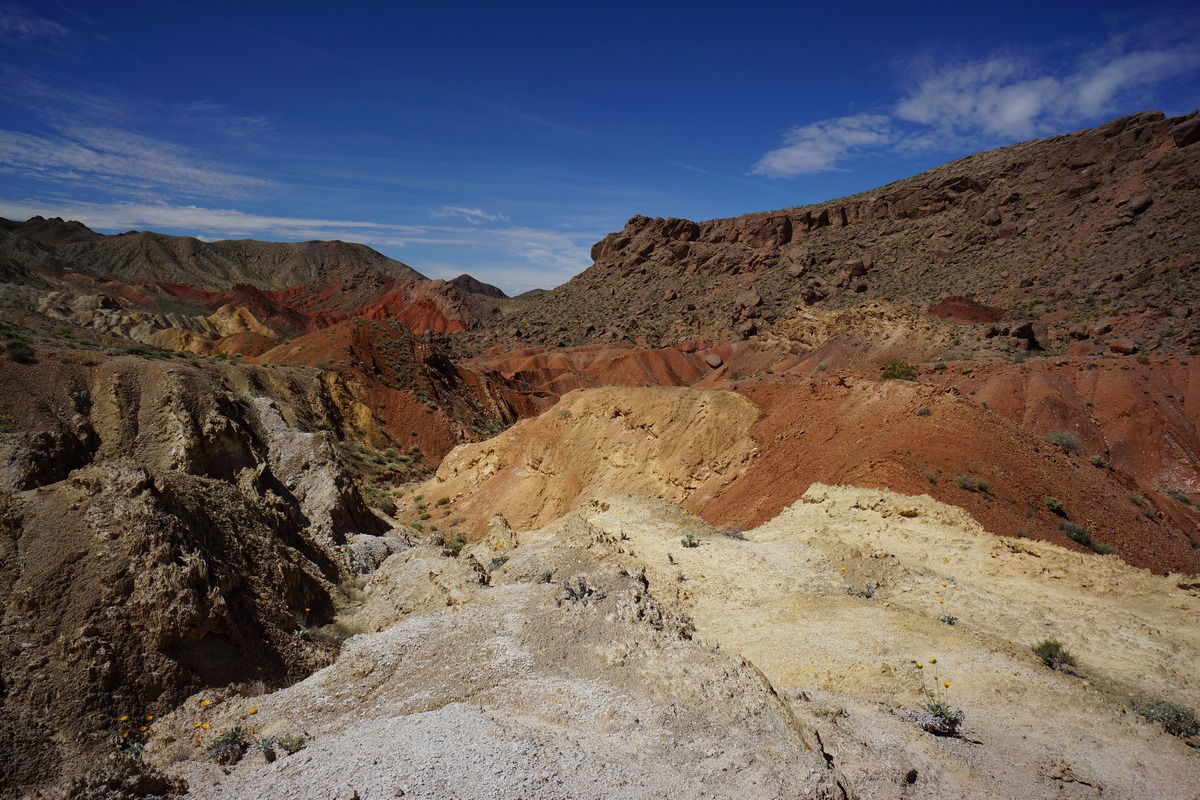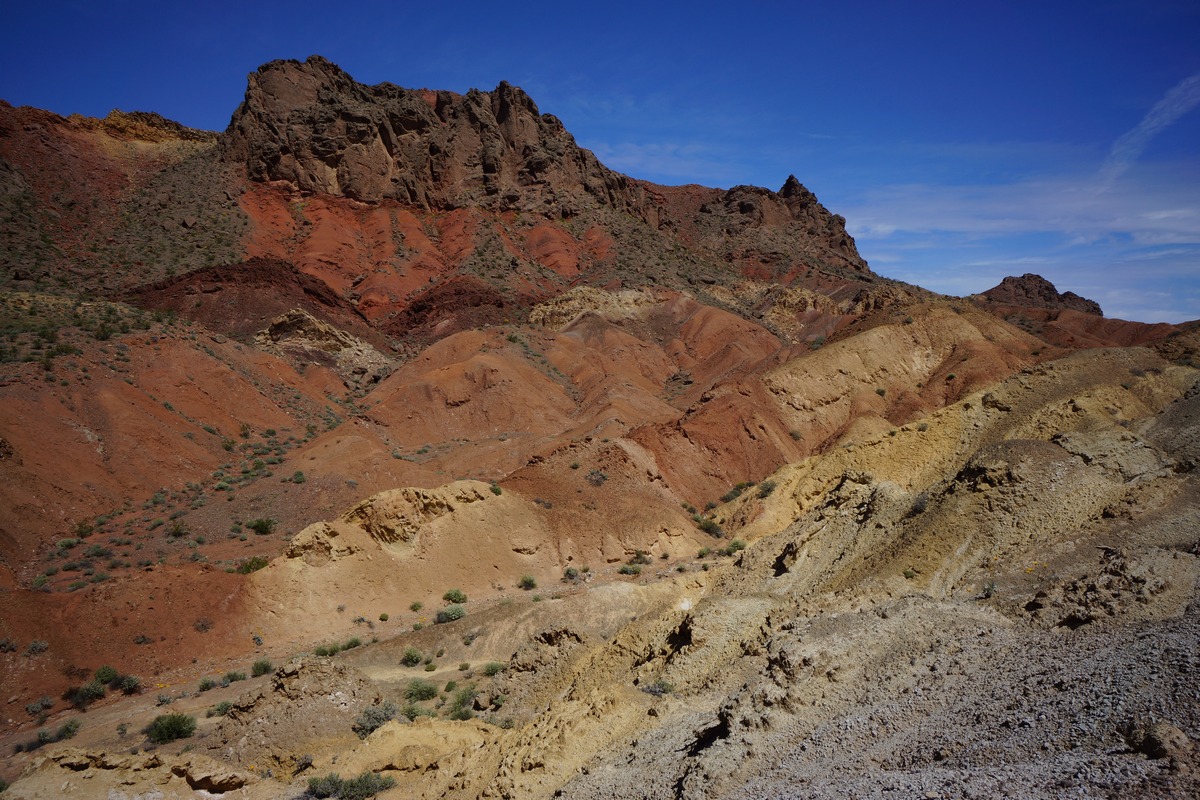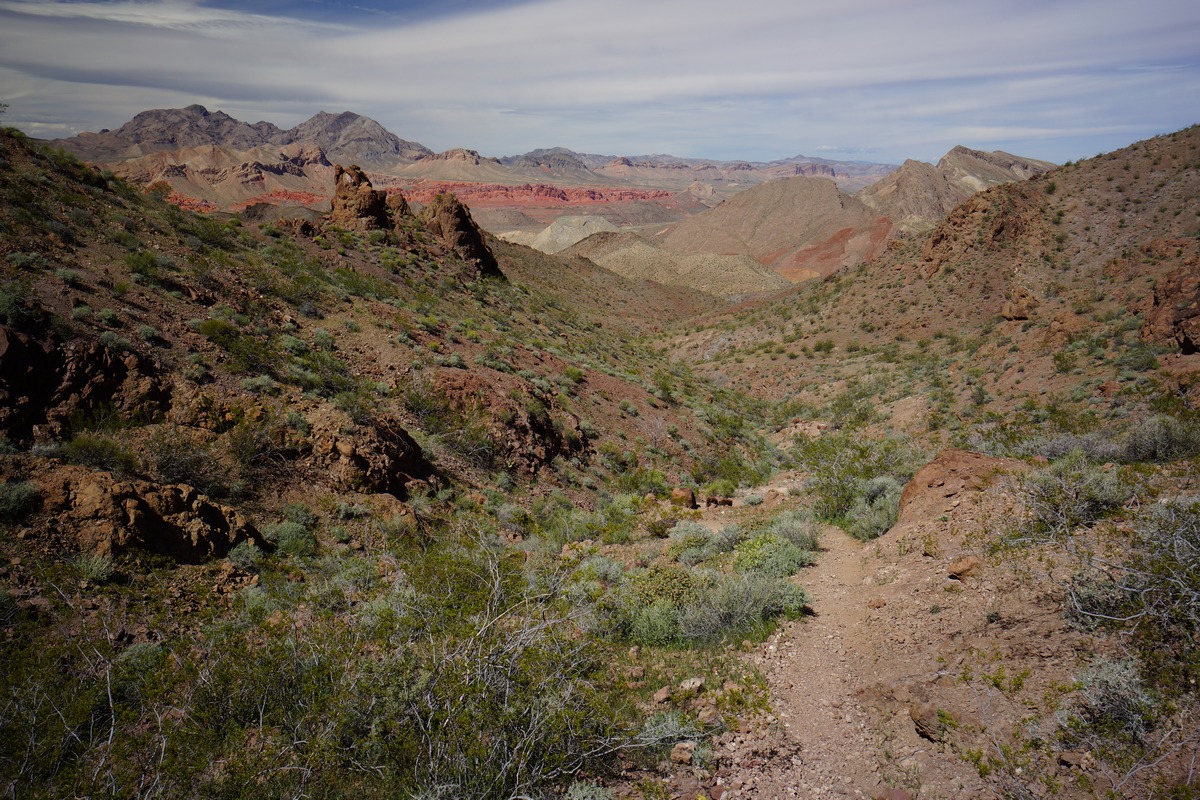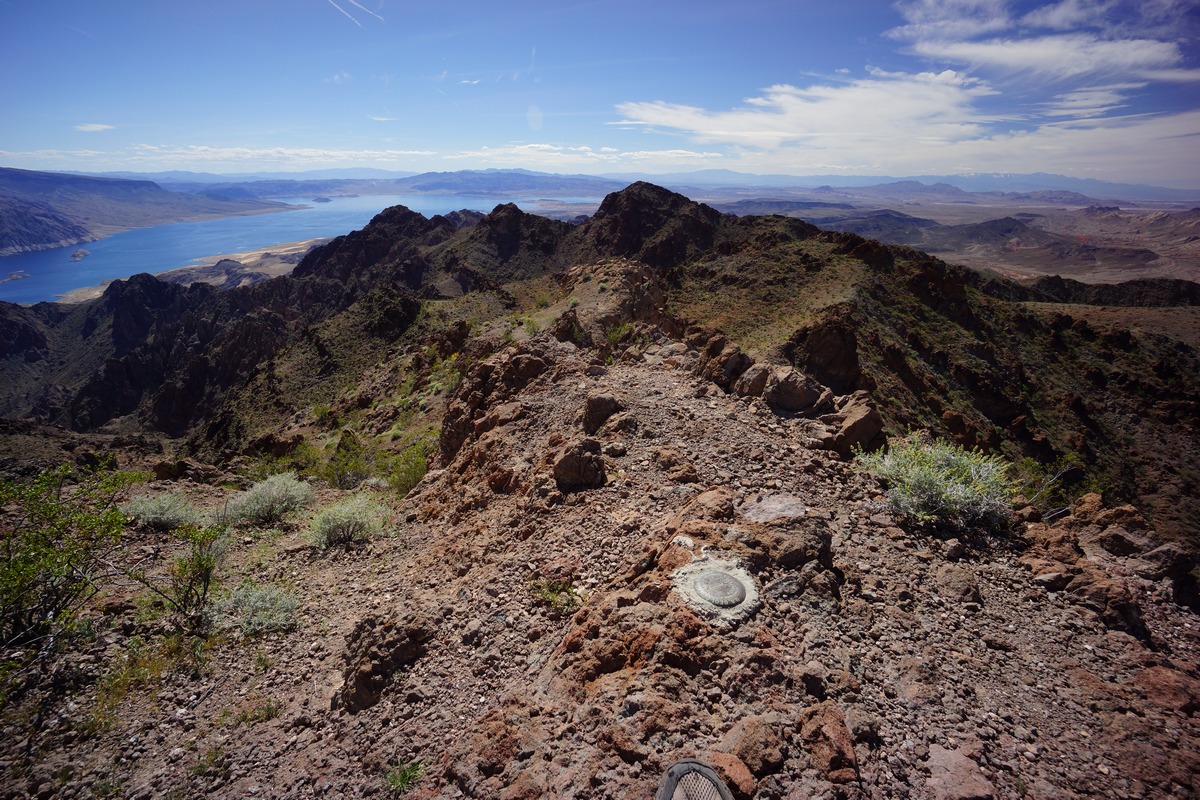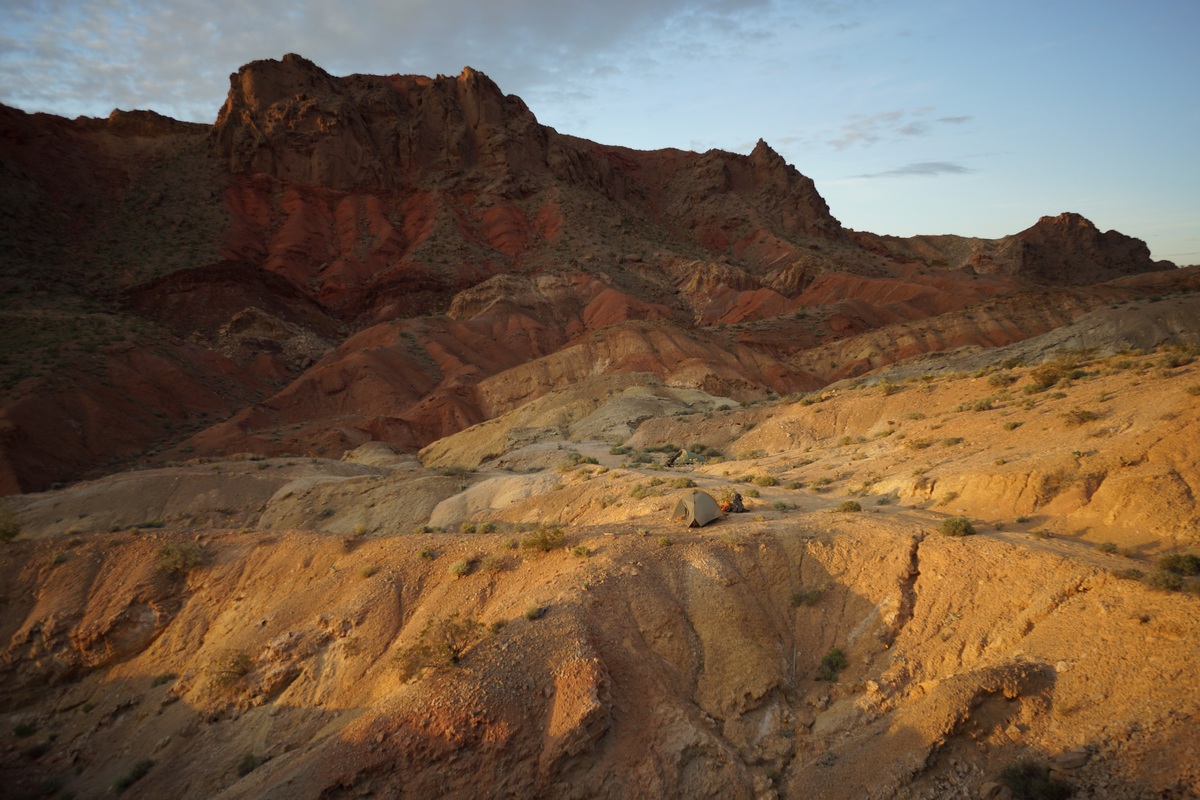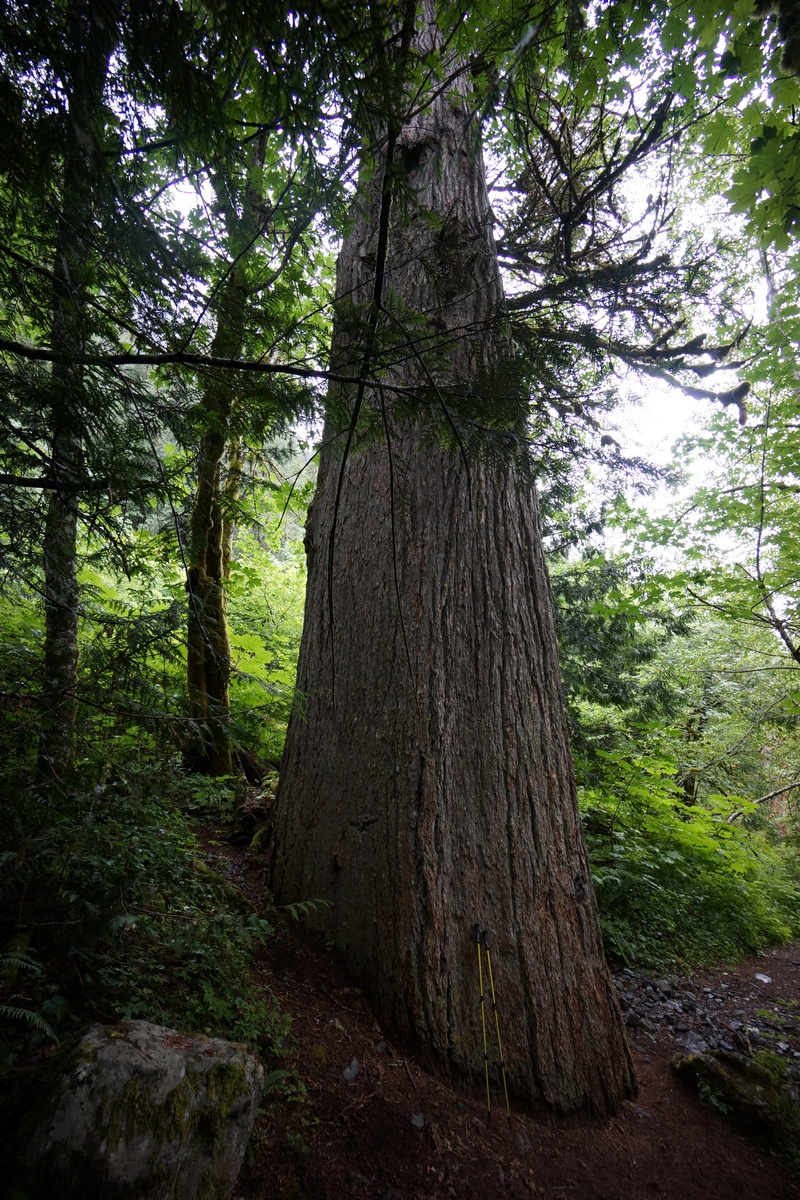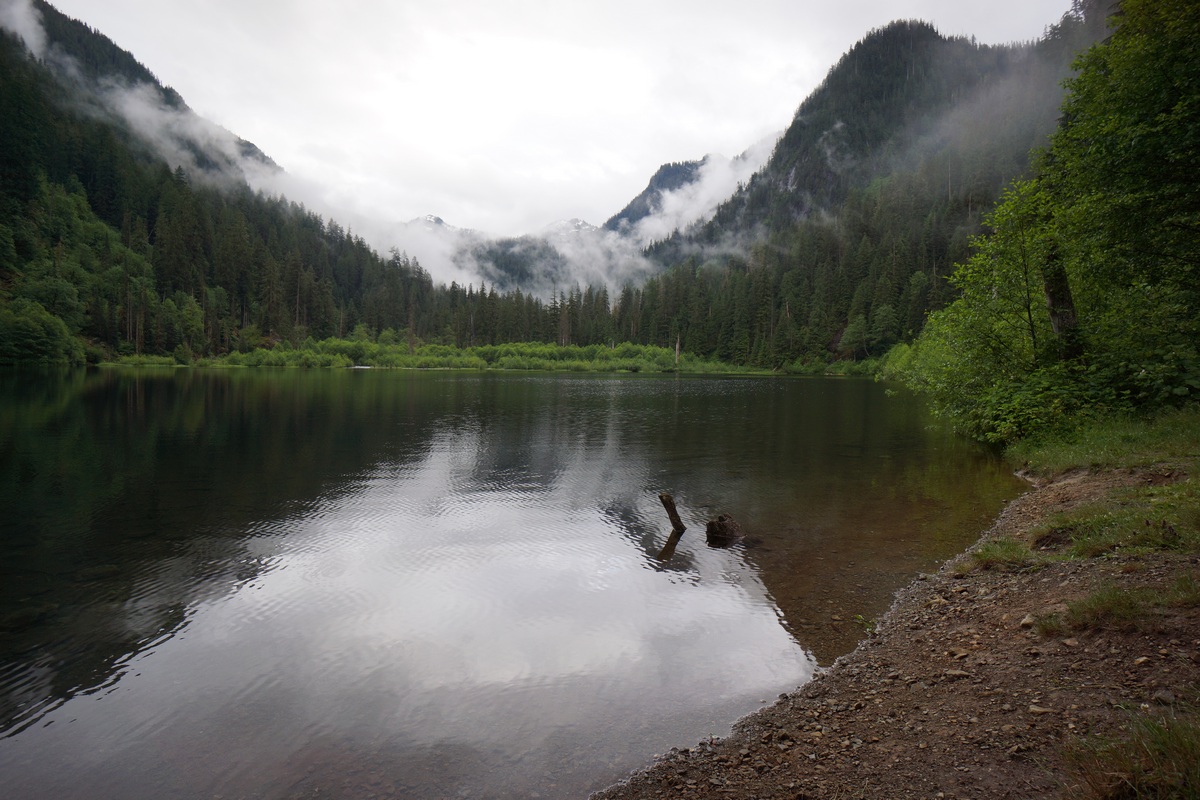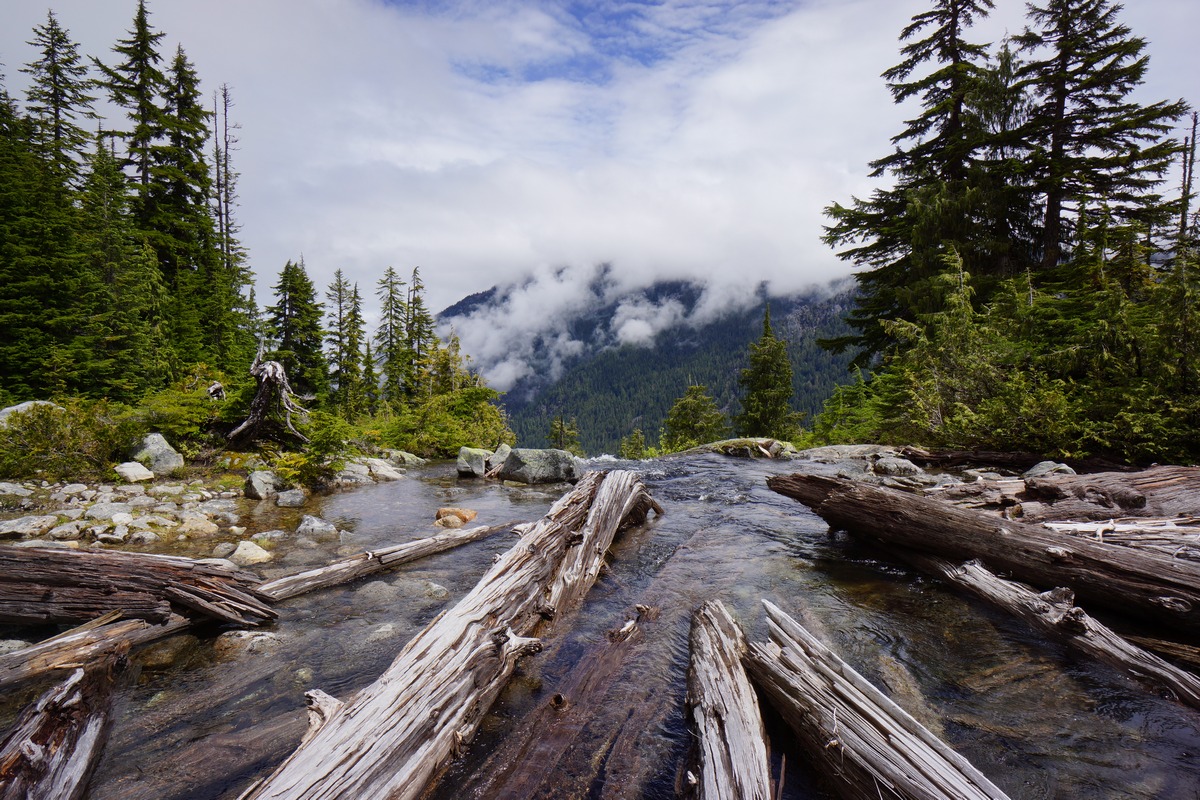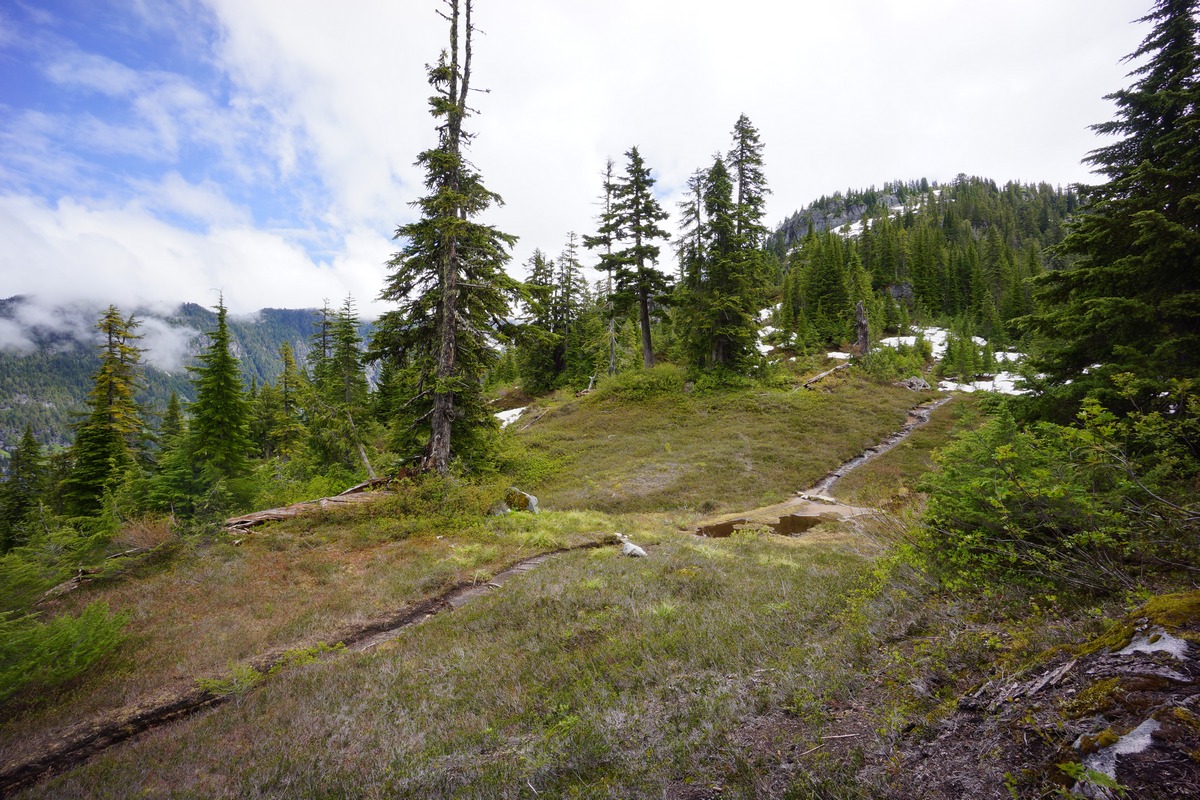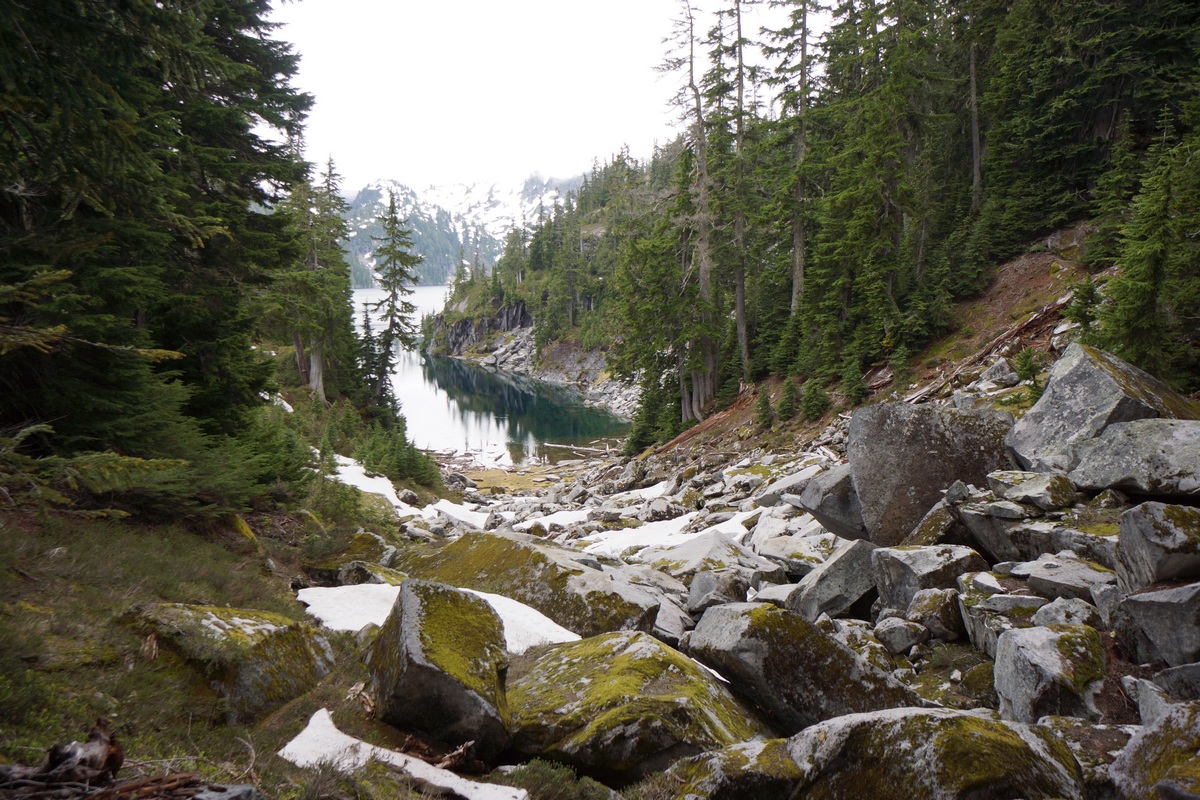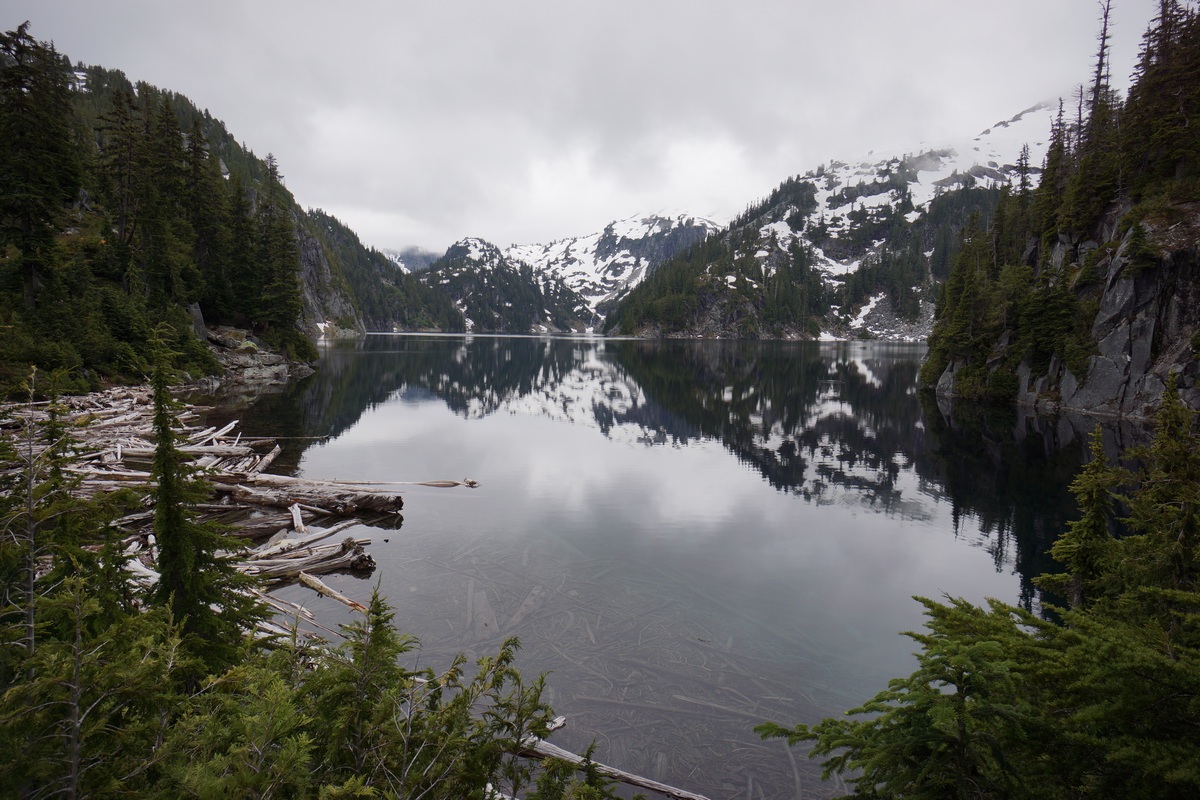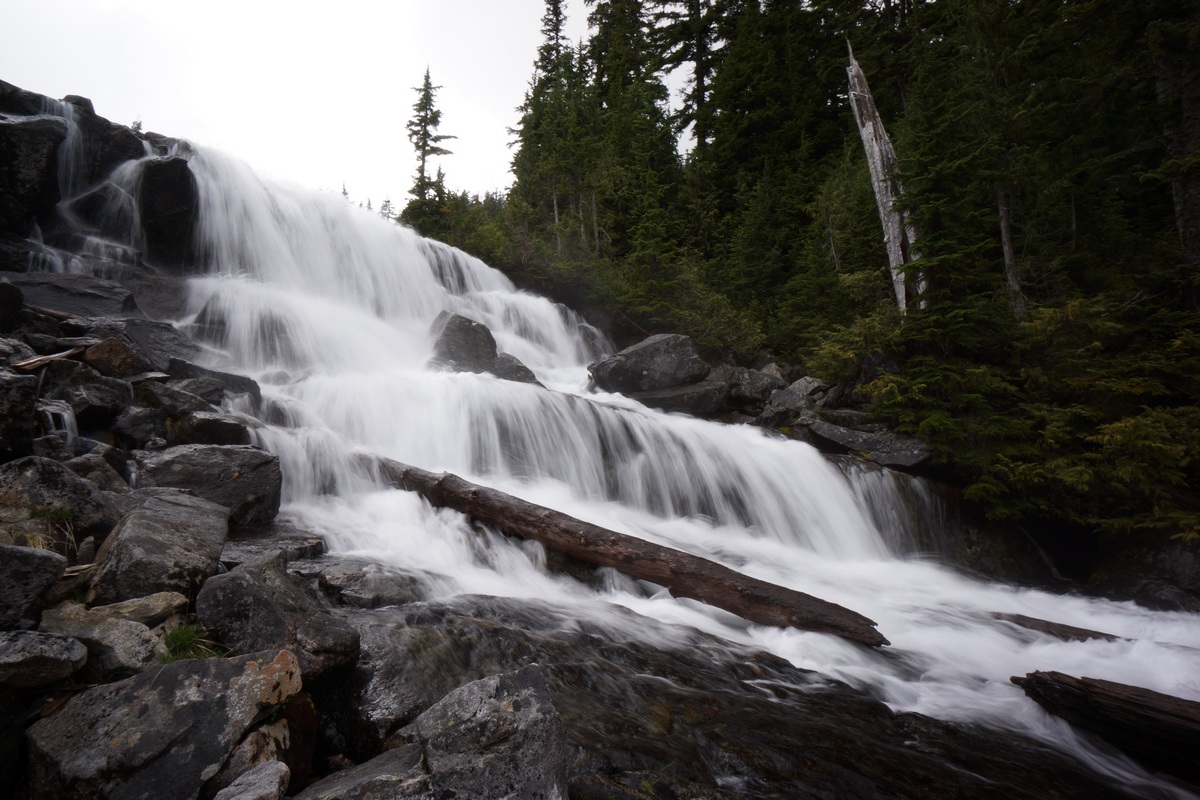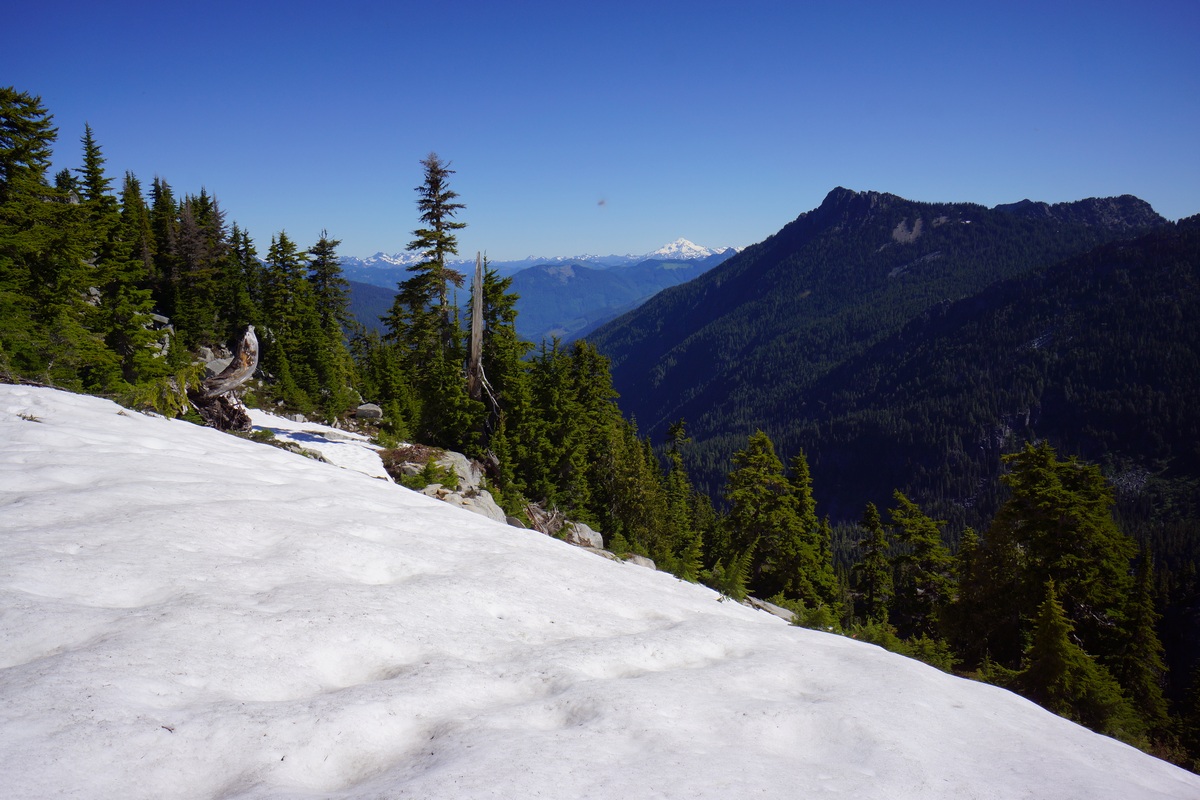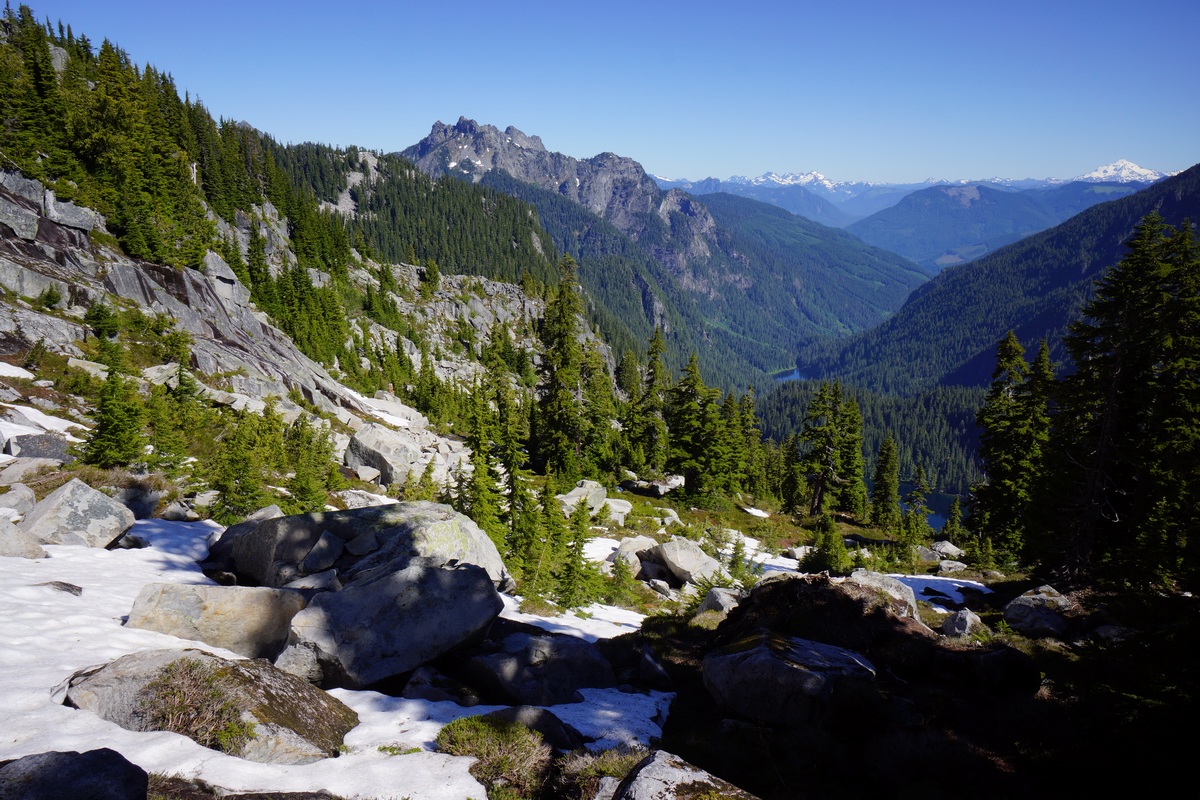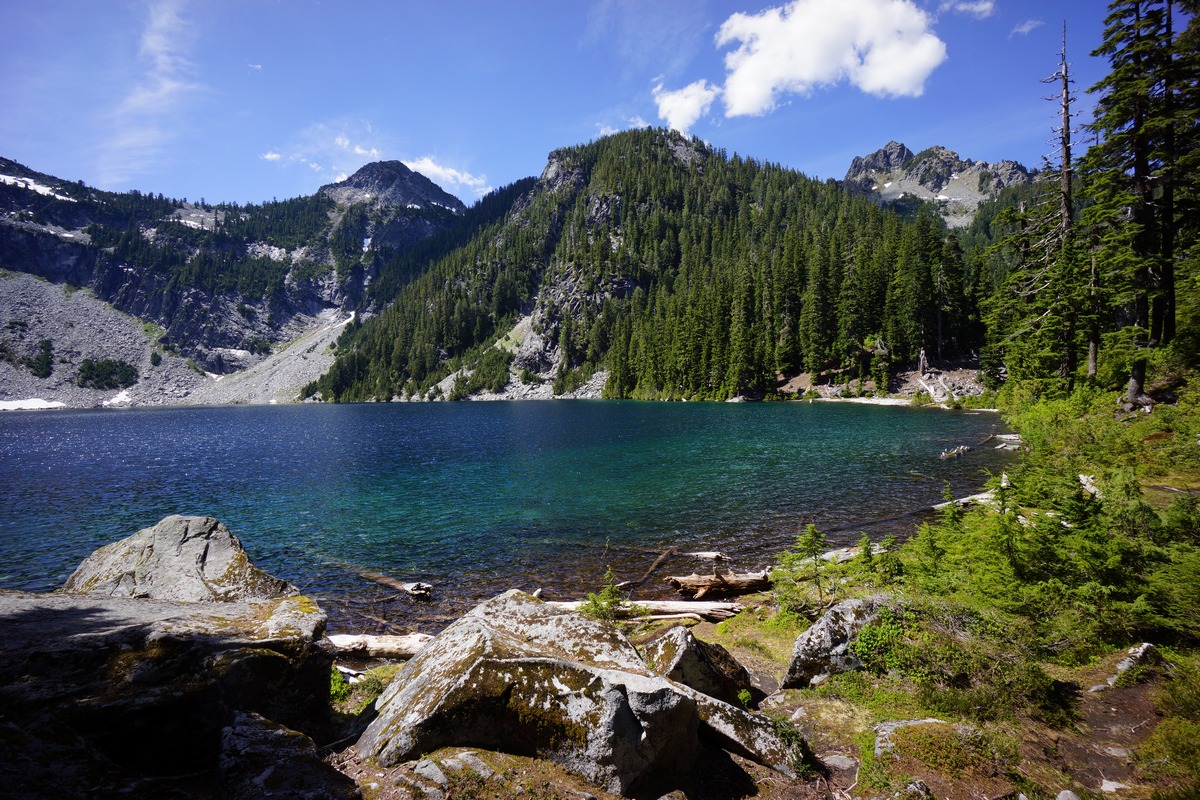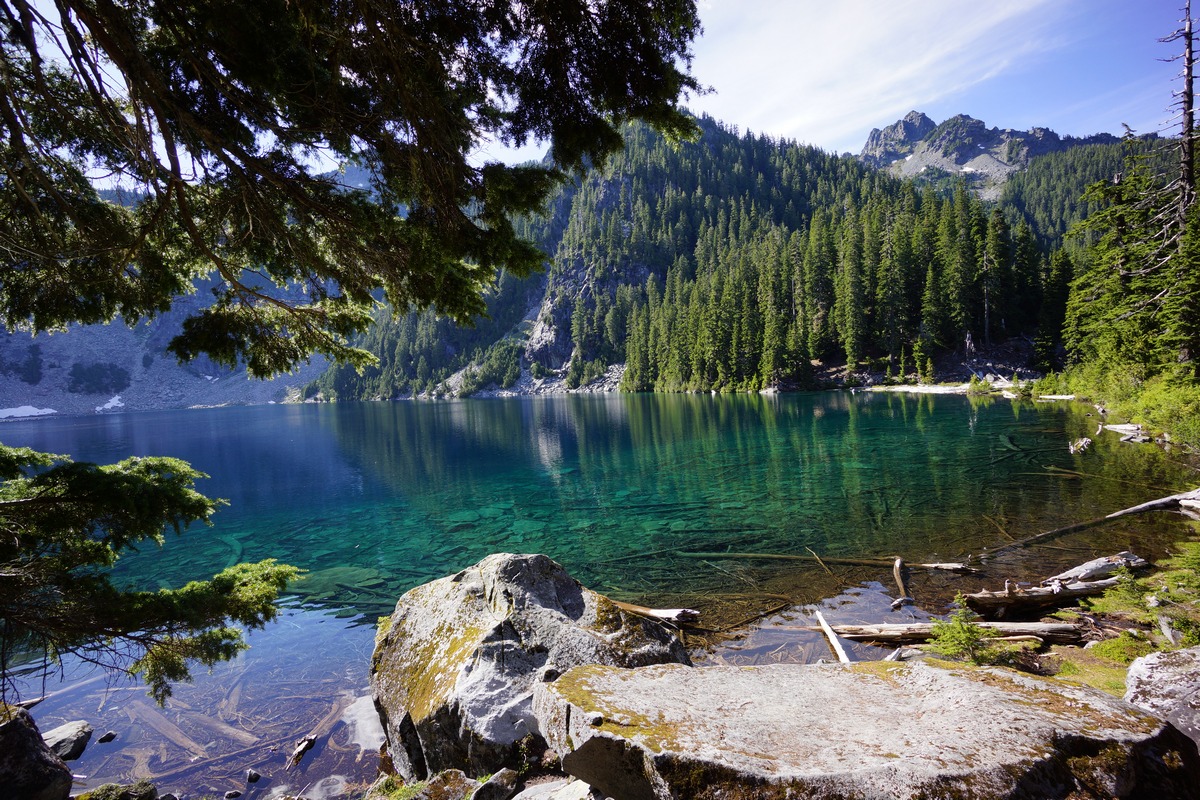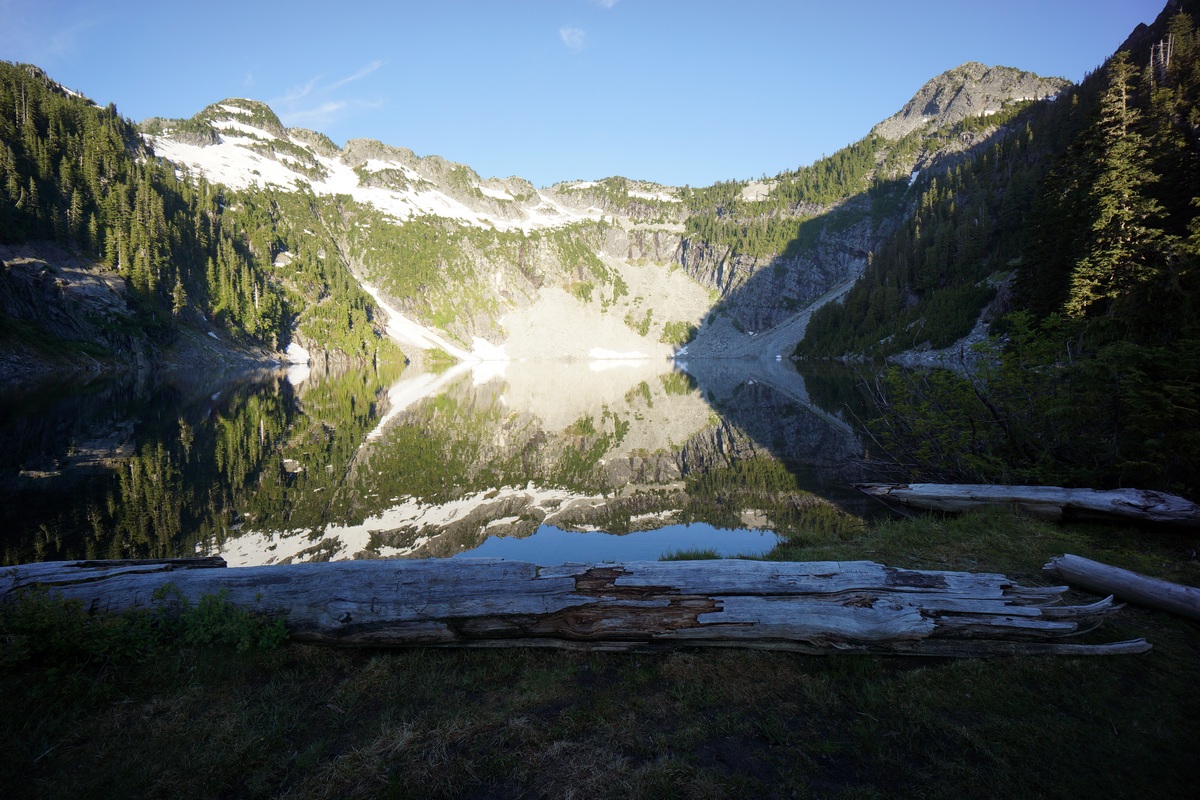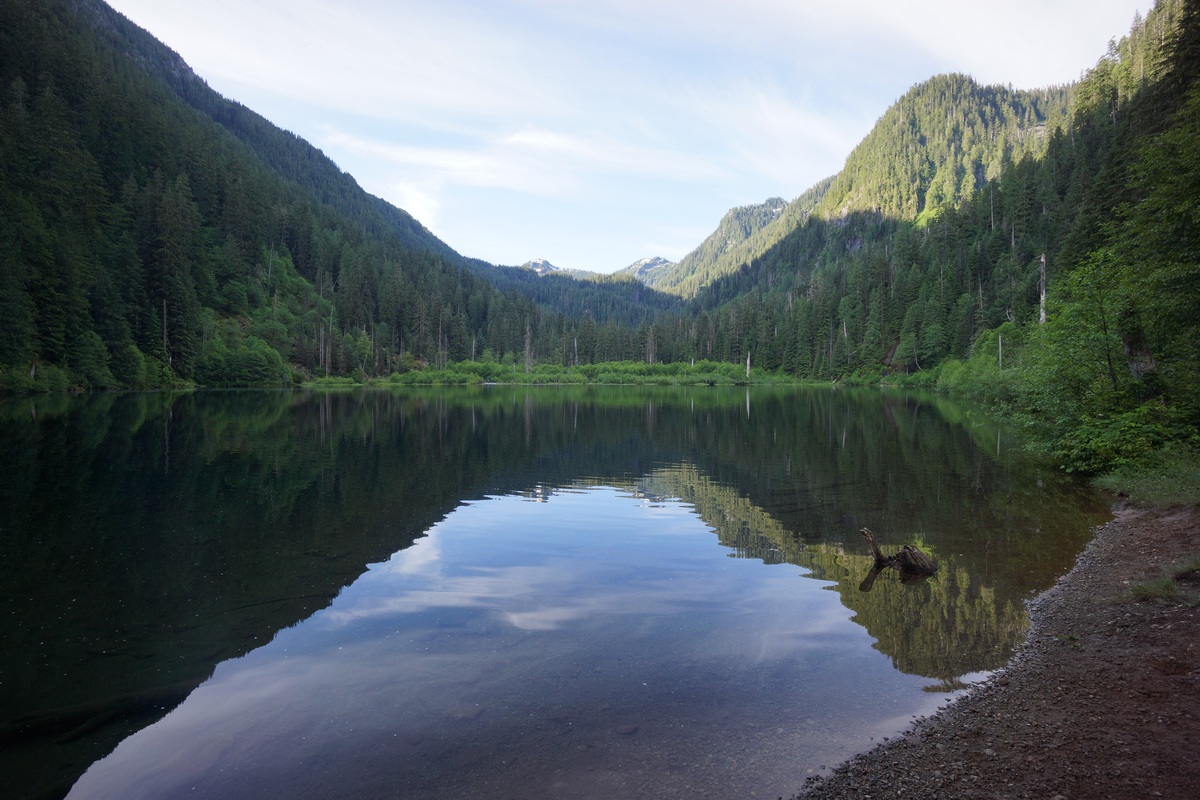Pinto Valley Wilderness, NV (LMNRA) – 3 Day 25 Mile Loop Hike March 2017
Backpacking The Pinto Valley Wilderness, Nevada (Lake Mead National Recreation Area)
View All Pinto Valley Wilderness Photos | Watch the Pinto Valley Wilderness Hike Video On Youtube
- Park Administration – National Park Service (Lake Mead National Recreation Area)
- Fees & Permits – No fees or permits to access the Pinto Valley Wilderness, but there IS a fee to enter the Lake Mead National Recreation Area (in which the Pinto Valley Wilderness is located)
- Trailhead – Northshore Summit Trail parking lot off Northshore Rd.
- Length Of Time Hiked – 3 days, 2 nights
- Miles Hiked – 25
- Route Difficulty – 6.5, except where on descent into Pinto Valley near the “choke point” on my GPS file where it’s an 8.5
- Fires Allowed – Yes, but only if you bring your own, or use driftwood below the high water line of Lake Mead (which is not nearby)
- Scenic Beauty – 9
- Solitude – 8
Pinto Valley Wilderness Pre-Hike Planning Notes
The Pinto Valley Wilderness is relatively new, only being designated a wilderness in 2002. Therefore there are not a whole lot of references to this wilderness online. Many people just refer to the area as the Lake Mead National Recreation Area, which is technically also correct since the Pinto Valley Wilderness is located within the LMNRA.
The northern boundary of the Pinto Valley Wilderness is Northshore Rd, and this is pretty much the only place to park unless you have a 4×4. Here, there are several pull-offs along the road where you can park for a day hike. But what about overnight hikes? Well, you aren’t supposed to park in the pull-offs overnight, and even that was OK with the park service, would you want to leave your car there? Probably not. For me, the only real option was parking in the Northshore Summit Trail parking lot. It’s located approximately a half mile east of mile marker 20 on Northshore Rd. The southern boundary of the wilderness is Lake Mead, the western border is Callville Wash Rd and the eastern boundary is Boathouse Cove Rd. Also not that Boathouse Cove Rd separates the Pinto Valley Wilderness (39,173 acres) from the Jimbilnan Wilderness (18,879 acres) to the east. You can access the Pinto Valley Wilderness from the east, west and southern boundaries, but by far the easiest is Northshore Rd.
Water sources in the Pinto Valley Wilderness are limited. While there are likely other water sources located in the Pinto Valley Wilderness, the two most prominent sources (from my pre-hike research) are Sandstone Spring and Cottonwood Spring. I did not make it to Sandstone Spring to check if it was flowing. I passed by Cottonwood Spring, but did not search for the source. I did see that an animal had dug down into the wash near Cottonwood Spring and there was a pool of water about 6 inches down. Neither one of these springs are reliable enough to count on as a easy water source (you might have to dig for water). Pack in all water you will need for this hike and assume you will not find any!
It does not appear that backcountry camping is very popular in the Pinto Valley Wilderness. The lack of trail heads with overnight parking, marked trails and water sources seem to indicate that most people use the area for day hikes. However, the off-trail enthusiast will find that the Pinto Valley Wilderness provides some excellent 2-3 day hikes to those willing to haul their own water.
Pinto Valley Wilderness Backpacking Maps
[sgpx gpx=”/wp-content/uploads/gpx/PintoValleyMar17RouteHiked.gpx”]Download GPX file of this hike
Here’s my caltopo map I used to plan my route:
Day 1 – Saturday March 25th, 2017
Miles Hiked – 8.26
Elevation Gain – 1228′
Route Hiked – Northshore Summit Trail parking lot to Pinto Valley near Sentinel Peak
Dan and I spent the previous day in the nearby Valley of Fire State Park, and camped in the Arch Rock campground. From here, it was about a 30 minute drive to the Northshore Summit trail head. It was cloudy this morning and was sprinkling when we were packing up our gear, but that quickly faded away. The drive along Northshore Rd was very scenic, and worthy of spending some time here by itself. However, we did not have the extra time, and drove directly to the parking lot.
When we arrived at the Northshore Summit Trail parking lot, we were the only ones there. Good sign. Yesterday, Valley of Fire State Park was packed. There’s a bathroom and garbage cans here, but that’s it. We left the parking lot around 9:30am and started walking east on Northshore Rd. While road walks are never ideal, this was the best route I could come up with that fit together a starting point, the destinations I wanted to hit and the time frame. Despite walking this paved road for 2 miles, it was beautiful country. Big views to the north, looking across Bitter Spring Valley.
After 2 miles, we reached a pull-off where another vehicle was parked. Here, we leave the road and head south towards the Pinto Ridge. We hiked up over a small ridge to start the climb up. The terrain is pretty jagged here, with lots of sharp rocks. As we climbed up the ridge, I came across a turtle shell. The turtle itself was long gone, but the shell was an interesting find. A few hundred feet farther and I saw a second shell.
Farther up the ridge, the path narrows as we reached the top of the “pass”. The vegetation was a little greener, thicker, and thornier here. Lots of wildflowers in bloom, and some of the cacti as well. There’s not much of a view form the high point, but this changes as you descend into Pinto Valley.
The descent from the top is pretty gradual at first. We could tell there was a steeper section ahead, which I anticipated. Now the views of Pinto Valley were materializing, and they were impressive. However, the immediate problem was the terrain that lies between us and the valley below. The steepness would have been enough to worry about, but of course, loose rocks and debris compounded the difficulty. The angle was such that you could grip decently walking down slowly, but only just. Any steeper and this would have been questionable. I crab crawled in a few spots after watching Dan fall a couple of times.
It took a good amount of time to safely work our way down this steep slab, only to be led to a choke point… a couple of boulders wedged between the steep, narrow canyon walls. There’s no easy way to climb down it, but there’s a route around it. Backtrack about 50 feet from the boulders and go up a ridge on your left (to the east). Here, there’s a more manageable route down and the rest of the way is less frightening.
Now down off the worst of Pinto Ridge, jumped down into one of the two washes, which merge, and headed out into the valley. It’s a whole new landscape here. In the wash we could see chunk of earth pushed upright, with a variety of layers visible. This isn’t solid rock like granite, though. It’s made up of compacted, crumbly dirt and smaller rocks.
After emerging from the wash, we found ourselves in the expansive Pinto Valley. Sentinel Peak was in front of us, dominating the view with shades of orange and red. We decided to camp here, on the north side of the valley, so we could have a good view of Sentinel.
We found a couple of flati-ish spots and cleared the sharp rocks to make way for our tents. The view was great, but there’s no shade anywhere nearby. After setting up camp, we took a break for lunch. Afterwards, Dan rested while I took some pictures.
After our break, we headed over towards Sentinel in an attempt to climb to it’s summit at around 2:30pm. The path to Sentinel from our camp involved dropping down into and climbing out of several washes along the way, before finding the main wash that runs through Pinto Valley. We took this to the Base of Sentinel where the route I had planned begins. The path up to the top was not very obvious from here, so I was hoping the track I created in Caltopo, based off someone else’s route up Sentinel, was accurate.
We started climbing up Sentinel, and quickly found the most promising route to be blocked by a huge boulder. We moved farther east and started uphill here. Dan wanted to go right up the mountainside whichever place looked easiest from his point of view, while I wanted to try and stick to the GPS route I created ahead of time. We both pursued various route options but keep finding ourselves in tough spots. I ended up breaking one of my Gossamer Gear LT4 trekking poles, again. Looking back, I think I’ve broken more of these poles than I have completed hikes with them. I don’t think I can use those poles anymore, need something beefier.
The climb was a lot harder than we anticipated. While we probably could have made it to the top and back to camp if we continued, we decided that it was getting late in the afternoon and didn’t really want to be getting back right at dark or after if the route continued to be as challenging. We turned around and headed back to camp, somewhat defeated. At least there’s Hamblin Mountain tomorrow, which should have an easier route up.
While we walked back to camp in one of the washes, we saw what looked to be bobcat tracks and poop. We saw lots of similar tracks throughout our hike, but of course, never saw anything.
When we got back to camp we still had no shade. Dan set up his emergency blanket (he was using it as a footprint under his tent) as a lean-to, and we had a nice shaded spot to escape the sun for a while.
There was a TON of plane and helicopter traffic overhead in this region. Commercial planes I understand as we’re not that far from Las Vegas. The helicopter though, I don’t understand why there were so many. Throughout the day we saw a couple per hour. Right before nightfall, I saw 6 in row, flying the same flight path spaced about 1 minute apart. Maybe some sort of training exercise?
Looking to the east, the views of Sentinel and the mountains beyond were colorfully illuminated by the sun now. To the west, the distant landscape looked lush and green as the sun shined on it, although it in reality the vegetation is much more sparse up close. Dan said it looked like Jurassic Park. I watched the sun set and headed to bed shortly after.
Day 2 – Sunday March 26th, 2017
Miles Hiked – 9.88
Elevation Gain – 2173′
Route Hiked – Pinto Valley near Sentinel Peak to Pinto Valley Castle
It was a calm night with no animal sounds or high winds. The only sound I could hear was Dan snoring, as we set up our tents a little too close together. I got up around 6:30 to watch the sunrise, and tried to wake Dan. Of course, Dan continued to sleep and didn’t get up until 7:30 or later.
While Dan wrestled with the agony of leaving his tent, I sat on a small hill near camp and took some pictures. The sunrise was not very impressive from this spot though as it was so high in the sky by the time it peaked out over the top of Sentinel Peak. I was already packed and ready to go by the time the sun rose and Dan finally left his tent.
We broke camp around 8:30, following the nearest wash to the main wash running through Pinto Valley. Walking in the washes is the easiest route through Pinto Valley. This is not because the terrain outside of the washes is difficult, but because the washes are cut steeply and often deep into the surrounding earth. Hiking in and out of them gets old after a while.
Hiking the main wash was very easy. We made good time as we traveled west through Pinto Valley. We passed an outcrop of rocks and boulders that people have been signing their names on for years, dating back to the 1920s. Even though some of the writing is nearly 100 years old, it still looks brand new. Is is really that old then? Surely they would have been weathered somewhat in 100 years, right?
West of the rocks with writing along the main wash, we could start to see the colors of Pinto Valley Castle in the distance. Soon we left the main wash, and headed up another wash towards Pinto Valley Castle. This is a really interesting area, visually and geologically. Lots of upheaval going on, exposing many different layers of sediment. Small patches of “badlands” can be found all over here too.
Pinto Valley Castle was impressive. Erosion has shaped the walls of PVC in an unusual way, with sharp edges and symmetry. The top is made up of some lighter colored sediment, while the bottom is comprised of a contrasting red color.
After heading general north for a while through the Pinto Valley Castle area, we abruptly turned west after passing by PVC. After hiking through a small patch of badlands, we noticed an obvious path up one of the ridges, which led us to the top of a small pass. This is the general area I wanted to camp, since it looked so colorful from the satellite maps I studied before coming out here. It certainly lived up to the hype I had in my mind. Now, we just needed to find a place to set up camp.
Coming down from the little pass, we followed an obvious path down and along the side of the high ground. This path appeared to be an old mining road or something. We followed it a short ways before find a couple of small flat areas for our tents. Excellent views, and enough space to spread out more than we did last night.
After setting up camp and eating lunch, we headed out to climb Hamblin Mountain. From camp, it appeared that there was a high and low path to take. We opted to take the high ground since we were already up here. This path led us generally where we wanted to go, but then started curving south. We backtracked a little and realized we had to go over a ridge to get to where we wanted to go. We should have taken the low ground from camp as it would have gone around this ridge, but I didn’t realize that at the time.
We followed the ridge for a while looking for a weakness. After a short but steep climb over it, we still didn’t see an obvious route to follow. We headed down hill and along the top of a very deep cut wash below. On the other side we could see a trail, but we needed to cross this wash. We found a spot to descend, and even saw a cairn in the wash. We figured we were on the right path now.
The land was changing from red washes and badlands to green, rocky mountainous terrain. We followed our new trail up a ridge and along the mountainside. The path was very narrow and barely cut into the steep slopes. Eventually this path merged with a larger one, and it was much easier to follow from here on out. We hiked a short ways before seeing a path that led down into the wash below, which looked easier and more direct than the route we took up here. We noted this and decided to go this was on the descent.
Next we encountered are first humans of the trip, a couple from Henderson, NV who a had just left the summit of Hamblin Mountain. We chatted for a few minutes and parted ways, knowing they had only been hiking 25 minutes from the top. I was really looking forward to this view!
The hike up was not technically challenging or particularly steep, but there were a few false summits. Really great views as your near the top. Not far from the summit, we passed an older couple from Colorado making their way down. The woman seemed bewildered that we had “large” backpacks on, and asked if we were camping at the top. Ha, nope. Just carrying our water, snacks, camera gear, etc.
We had the summit of Hamblin Mountain to ourselves when we made it up here at 2:30. It had taken us 2 hours from camp. From the top I could see Lake Mead, Bowl of Fire, Sentinel Peak, Pinto Valley and all the other landmarks for many miles. Las Vegas lies hidden from view in a valley, but beyond that the snow-capped peaks of Mt. Charleston can been seen. Several USGS markers dot the summit as well as a summit log/register.
We stayed on the summit for about an hour taking pictures and soaking in the view. However, we were also soaking in quite a bit of sun, and with no shade, it was time to head back to camp.
Dan went ahead of me as I snapped a bunch of pictures on the way down. For some reason, I enjoyed the view better going down than up.
Before we knew it, we reached the path that leads down into the wash that we noted on the way up. We headed down here and found this route to be quite obvious, and in fact, the actual route. The first trail we found on our way up was actually an alternate route the just happened to meet up with this main trail. This was confirmed by passing the same cairn that we passed in the wash on our way up. We originally thought the cairn marked the way to the main path that we took, instead, it marks the main path which we crossed right over without realizing.
Our path in the wash was leading us directly back to camp now. We passed the junction of the old 4×4 road that passes by Cottonwood Spring and heads out to Northshore Rd. This would be the route the day hikers would have taken, parking at a pull-off along the highway. We walked past this junction and the path led us right back to camp in a very direct way, much more so than the way we took up the mountain. We made it back to camp in only 1 hour from the top of Hamblin, half the time it took to reach the top.
Back at camp, we sought out the only shade around and exploited it for a while. Having not eaten anything since noon, which was just some snacks, I devoured my bacon & cheese wrap for dinner. Dan was running lower on water than I, so I gave him a half liter. That’s about all I had left myself when I went to bed.
Dan was whooped and went to bed at 6pm. With another hour and a half of daylight left, I couldn’t do that. I found a decent spot to sit and wait for sundown. Several bats were out at dusk, and flying closely overhead too.
Day 3 – Monday March 27th, 2017
Miles Hiked – 4.99
Elevation Gain – 531′
Route Hiked – Pinto Valley Castle to Northshore Summit Trail parking lot
I woke up at 5:45 this morning. From my tent I yelled, “Hey Dan, time to get up”. To my surprise, he actually did get up without any additional prodding. That’s good, because I have a plane to catch at 12:45pm this afternoon, and we need to hike back to the car, drive back to Vegas, get some food and clean up. Originally I planned to hike an off-trail route back to the car, but worried about time, we opted to take the route the Hamblin Mountain day hikers use to get to Northshore Rd, then road walk a few miles back to the car. This would be the safest route from a time perspective.
We packed up quickly this morning and were moving by 6:30. We took the low ground this time for a direct route to the junction with the old 4×4 road, now called the Cottonwood Wash Trail.
Hiking the Cottonwood Wash trail was easy. Some spots were more narrow than others, and made you wonder how a vehicle passed through. Much of it is wider though. This road would have been in use up until 2002 or prior, when the area was designated as the Pinto Valley Wilderness.
A lone Cottonwood tree stands in the middle of the wash at Cottonwood Spring, hence the name. I did not see an obvious source, but I didn’t look around much either. There were lots of thick, green shrubs and bushes in some areas, an indicator of water, but I had no desire to wade through them looking for water. We did see a small hole dug in the middle of the wash with water about 6 inches down, but no natural emergence of water to the surface.
After leaving Cottonwood Spring, we headed down the home stretch. This was offered the same interesting geological features as others, a variety of rock and sediment layers exposed by upheaval.
When we reached Northshore Rd, we headed east. We still had about 3 miles to cover before getting back to the parking lot. I didn’t even mind walking the road so much since the views were so great. It was a steady incline the rest of the hike back.
We reached the Northshore Summit trailhead at 8:30, plenty of time to take care of my pre-flight needs. Another successful adventure under the belt.
Final Thoughts About Hiking The Pinto Valley Wilderness
This place exceeded my expectations. It’s uniquely colorful, and an all around cool place. Access is tough and some of the off trail segments can be challenging. Lots of aerial traffic remind you of how close this place is to civilization, yet we still felt solitude. Especially at night. The nights were calm and silent, with no animal sounds. We saw few animals the entire trip, just a couple of chipmunks and birds. The vegetation wasn’t too thick or thorny overall, only a few short spots where we encountered that. We saw no snakes or spiders, just a couple of butterflies and a beetle. I was expecting wildlife to be a little more active this time of year.
Camp on our second night was my favorite. You can’t go wrong pitching your tent anywhere near Pinto Valley Castle in my opinion. Hamblin Mountain is an easy hike with a great view, and would make a great day hike (as the two couples we passed had done).
Alpine Lakes Wilderness, WA – West Fork Foss Lakes Trail Hike June 2016
Hiking The West Fork Foss Lakes Trail In Washington’s Alpine Lake Wilderness
View All Photos | West Fork Foss Lakes Youtube Video
- Location – Alpine Lakes Wilderness, WA
- Park Administration – Mt. Baker-Snoqualmie National Forest
- Trail Name – West Fork Foss Lakes Trail # 1064
- Fees & Permits – Northwest Forest pass required, or can pay $5/day for a day pass. You can get either pass at the US Ranger Station located here: 74920 Stevens Pass Hwy Skykomish, WA 98288. It’s on the north side of HWY 2 right about a half mile west of Foss River Rd, which takes you to the trailhead.
- Travel Logistics – Flew into Seattle, rented a Chevy Cruze
- Length Of Time Hiked – 4 Days, 3 Nights
- Miles Hiked – 20
- Trail Type – Out and back
- Trailhead – West For Foss River Trailhead
- Trail Difficulty – 6.5/10 (not including off-trail segments)
- Fires Allowed – No, not above 4000ft or at any of he lakes I passed
- Solitude – 6.5
- Scenic Beauty – 8
West Fork Foss Lakes Trail Maps
[sgpx gpx=”/wp-content/uploads/gpx/WestForkFossLakesTrailAllDaysOneTrack.gpx”]Pre-Hike
My work sent me out to Seattle for a conference, and I had the option to stay the weekend. This was my first trip to Washington state, and naturally I’m going to use that time to squeeze in a hike. A former co-worker had recently moved back to Seattle, and we planned to do this hike together. However, as with several of my past attempts to hike with a buddy, conflicting schedules and priorities meant I’d once again be hiking solo. While I totally understand and respect his decision to stay behind due to more important issues at hand, the fact remains; another hike with nobody to share the memories with.
Similar to my last hike in Arizona’s Sierra Ancha Wilderness, I’ve done much less research and planning on the are then I normally would. The big difference here is that I felt much more out of my element before the hike. While I have a fair amount of alpine hiking experience in Colorado, Utah and Wyoming, I’ve never been anywhere that had glaciers at 6000 feet. There are no snotel stations nearby at the 5000 foot mark, around the highest elevation this hike will see without any additional off-trail climbs I may decide to take on. Plus, all of my alpine hikes have been in late July or August, not late June. I set off on this adventure without any concrete knowledge of how much snow to expect at what elevation, although I felt pretty confident based on the little research I did that I’d be alright up to around 5000 feet. Still, the unknown awaits me.
Preliminary research showed that there was an avalanche that had blocked the road to the West Fork Foss River trailhead in February, which persisted into early June. A recent trip report on wta.org showed that the road had been cleared, but unfortunately the person who left the report had not actually hiked the trail to report on the snow pack conditions. Only 2 days before my hike, I learned that the avalanche debris had been cleared. Also, I discovered that the road would easily allow passage of a small car, even a Prius, despite the information on the forest service’s website about this road being for high clearance vehicles only.
Day 1 – Friday June 24th, 2106
Miles Hiked – 4.67
Elevation Gain – 2694′
Route – West Fork Foss River Trailhead to Copper Lake
I left the Seattle area in the early afternoon today and headed to the mountains. Once on Hwy 2 and east of Monroe, the drive was pretty scenic. I stopped into the US Ranger station on Hwy 2 in Skykomish to pick up a couple of day passes for parking at the trailhead. $5 bucks a day for anyone who doesn’t have a Northwest Forest Pass, which was $30.
The road to the West Fork Foss Lakes trailhead was cleared and smooth as any dirt road is going to get. It looked like they just left a bunch of the avalanche debris and turned it into a little hill to drive over. There were only a couple of small potholes, not large enough to cause any damage if one were to drive right over them at any speed. At the trailhead, there were about 12 cars. I was expecting there to be fewer cars here, considering the fact that it was raining and the trailhead had only been open a few weeks at most.
I hit the trail at 5pm. The plan for today is to hike to Trout Lake, the first lake and last landmark before the trail begins it’s ascent towards Copper Lake. The trail starts out in a lush looking pine forest with lots of moss growing on the trees. It looked similar to what I envisioned the Olympic Peninsula to look like, but I’m sure it’s quite different.
After a short while I reached the bridge crossing the West Fork Foss River. The water was flowing with some force and was quite loud. Some ways past the bridge I passed a huge pine tree, much larger than the others. This old-growth giant was obviously spared the ax when this area was logged in the past. Really impressive to see a tree of this size.
Next up along the trail was Trout Lake. I went down to the shore line to snap a picture, but with all the clouds, it wasn’t that great. When I turned around I saw a tent in the woods just off the trail. I continued along the trail and saw many more tents, I estimate at least 10-12. So much for camping here tonight. Doesn’t looks like there was an open spot, even if I wanted to camp here. These people seemed not to care that they were camping just 50 feet from each other. It’s one thing if you’re part of a large group, but otherwise, why would you come all the way out here to camp within sight of another person? That’s not my idea of camping.
It was around 6pm now as I pushed on past Trout Lake and headed up towards Copper Lake. While I didn’t really want to make the hike up to Copper Lake tonight, I figure I’d have more time in the high country tomorrow and should be able to snag a good campsite tonight. Not long after leaving Trout Lake behind and starting the climb up the switchbacks, the brush along the trail started to choke the path. It was now impossible to avoid the wet brush lining the path, and before long what little of me was dry became soaking wet. Water was sloshing out of my shoes now. This was pretty crappy and not what I was wanting to get into just 1.5 hours from the car.
There weren’t many views from the trail as it winded up to Malachite and Copper Lake. However, the sound of a waterfall was present much of the way and there were a couple of good views of it towards the top. This waterfall was coming from the Copper Lake outlet. There was a decent campsite that probably would have worked for my hammock too around 3500ft, but why stop here? Just a few hundred feet from the top now, I pushed on.
When I reached Copper Lake, I saw a sign for Toilet and a path leading off into the woods. Didn’t realize they had toilets up here. I’ve only seen them in a handful of places, typically where human impact is large. That must be the case here as well.
I passed two young girls cooking hot dogs in their tent vestibule as I searched the are for a campsite. It was now around 7:45 and I wanted to find a spot to hang before it gets too dark. It took a while to find the right pair of trees. I’m learning that finding good hammock sites can be tougher then tent spots. Let’s face it, all pre-existing campsites are generally flat and will accommodate a tent, but not all pre-existing sites have trees, let alone trees spaced the right distance apart and of the right size. Some of these trees were so large, I couldn’t even fit the hammock webbing around it!
Finally got my hammock and tarp set up just before dark. It’s been a while since I’ve set up the tarp over the hammock and that took me a good while. Just in time though as it did start raining a little bit right after I went to bed. It was a good hang and super comfy, so I had no trouble falling asleep tonight.
Day 2 – Saturday June 25th, 2016
Miles Hiked – 4.81
Elevation Gain – 1788′
Route – Copper Lake to Big Heart Lake
It rained a bit throughout the night but not very hard. Either way, nothing of mine dried out. The trees were drip-drying this morning and I didn’t feel motivated to leave the tent until 9am. Nothing like putting on soaking wet shoes and socks when it’s 45 degrees out! It took a while to break down everything this morning with all my gear being wet, and I didn’t get on the trail this morning til around 10:15.
Unfortunately the weather was still looking crappy this morning. The forecast all week had been calling for rain Friday with it clearing overnight, leaving the rest of the weekend to be rather nice and sunny. So far, just clouds, and looks like it might rain at some point.
I worked my way around Copper Lake, which looked like it would have been much more picturesque under blue skies. I didn’t see many good, obvious campsites the rest of the way around the lake. I was looking because I may decide to camp here again on the way back. After all, I didn’t really get to experience this lake at all since I’ve been here.
The trail winds away from the lake towards the north end, and off into the woods. It was a short hike over to Little Heart Lake from here. The stream outlet was jammed with logs like the others, and provided one of the better views of the lake in the immediate area of the trail.
Moving on past Little Heart Lake, I started to encounter more downed trees. One was particularly large and kinda difficult to get past. After that, the trail continued to climb up over a small ridge. The thick cloud cover prevented any real views from breaks in the trees up here. In this area, I saw the first snow along the trail around the 4400ft mark. The trail along this ridgeline tops out around 4925ft before descending down towards Big Heart Lake. After a few switchbacks, the trail levels out and enters a little meadow littered with fallen rocks from the cliffs above. I ended up camping along a hill above this meadow later tonight, but at this moment I hiked right past it.
After roughly 2 miles from Little Heart Lake, I reached Big Heart Lake. There was a nice campsite sitting just above the lake’s outlet on the north side. At the moment though, it was occupied. I kept moving and made my way down to Big Heart Lake’s outlet. There was a huge logjam here that required crossing in order to continue along the lake. These were huge logs and pretty sturdy, which made for a simple crossing.
Now on the other side, I had a better look at the waterfall that is the result of Big Heart Lake basically pouring off a cliff. After a quick look and a few pictures, I moved on. I figured I’ll be back through here later, and might as well wait until the skies clear up for better pictures.
I continued up the trail along Big Heart Lake and found a couple of spots with sweeping views of the lake. Best views yet during this hike. Tons of mosquitoes up here though, but they’ve been pretty much everywhere.
Further up the trail I started hitting more snow. It wasn’t super deep, but my feet were occasionally punching through hollow spots in the snow. It was tough to keep sight of the trail at this point as well. I intended to try for Chetwoot Lake, but I decided to turn around and head back to Big Heart Lake and just try to dry out and enjoy the day, maybe do some fishing.
I headed back to the outlet area, and noticed that the prime campsite that was occupied earlier was now open. I dropped my pack here and laid claim to it, only to find out shortly after that my hammock would not fit between any of the trees here. Bummer. I spent the next hour at least trying to find another spot to camp. It’s insane to me to come all the way out to a place like this and take a campsite with no view of anything, but that’s what I ended up doing. The trees here make it very hard to hang a hammock since they’re so large. The spot I found was on a little hill at 4675ft overlooking that little meadow I mentioned earlier, on the extreme north end of Big Heart Lake.
My campsite was on a slope, which kind of sucks for a campsite, but it works when you have a hammock. After getting camp squared away, I headed down to the lake to do some fishing. From my campsite, there was a boulder field leading downhill towards a protected cove on the very northern tip of the lake. I worked my way around the west side of the cove and found a couple of nice boulders to sit on and fish from.
I didn’t see any fish in this corner of the lake. I’m sure there would be more by the logjam at the outlet, but it also looked pretty snaggy. The color of the water was that deep, vibrant blue which happened to be clear as glass at the moment. Visibility in the water was high, and there was a nice reflection of the mountains on other portions of the water.
After heading back up to camp, I grabbed my camera gear and headed back down towards the waterfall. There now was a couple camped at the prime spot. The downside of this campsite is that the trail runs right through it. Not my problem now I guess.
Now down at Big Heart Lake, I crossed the outlet and worked my way down the waterfall some more. It was pretty steep here, but I ended up descending more ground than I thought I could. This provided some cool views of the waterfall, although the grey sky was still washing out my photos.
I climbed back up to the lake outlet and continued up hill to some good vantage points I encountered earlier. However, all of these spots were now occupied with other campers, so I just headed back to camp for the night. I was getting tired of having soaking wet feet anyways.
For dinner I had a 100% whole wheat tortilla with cheddar cheese and pepperoni. I scarfed that, and was glad to have an appetite this time unlike some of my other hikes.
The sky started clearing up a little just as the sun set, through the trees and out of my direct sight. The sky was red and pink, it looked like an awesome sunset for someone else. For me, with no campfires allowed up here to keep the mosquitoes away or dry my wet shoes and clothes, I just headed to bed.
Day 3 – Saturday June 26th, 2016
Miles Hiked – 6.59
Elevation Gain – 2158′
Route – Big Heart Lake to Malachite Lake
I woke up at 2am to pee, and the stars were out and shining bright. When I got out of my hammock at 7, the sky was completely blue without a cloud in the sky. Finally! I was excited to have a day with some good weather to finally take full advantage of this beautiful area.
After packing up camp, I decided to head back up the ridgeline above Big Heart Lake towards Chetwoot Lake. I didn’t really intend to hike all the way to Chetwoot at this point, but I did want to get high enough to get a proper view. Up on this ridgeline, overlooking Angeline and Big Heart Lakes, should provide some of the best views of the hike.
On my way up the ridgeline towards Chetwoot, I passed a group of guys I talked to yesterday. They said they went up the ridge and descended halfway down to Angeline Lake. Well, I’m gonna check it out. Point 5359 seemed like a good destination, where I should find ample views.
I continued up the trail until it hit some snow patches and petered out. There were sets of footprints to follow though, so that helped. There was a faint footpath to follow much of the way from here on out, but it’d be real easy to lose it in some spots. It’s obviously not a maintained trail anymore.
The path I followed had me working my way over a smaller ridge at around 5000′. On the other side, the path became very faint and I wasn’t sure if I was following an old game trail at one point, but as I made my way down a steep section the path reappeared. The path descends downhill a bit in the direction of Delta Lake, going as low as 4840′ or so before swinging back uphill. There were some cairns here and there to follow, but not everywhere they were needed. The path lead me to a cliff overlooking Angeline Lake, my first glimpse. Nice!
The final push up to point 5359 had more snow. Even up here, the mosquitoes were relentless. I battled them up to the top, where I stopped at a small saddle before the actual summit. Great view, but still some trees in the way.
The climb up to the top of point 5359 was short and easy from here. This is a better vantage point, with less trees obstructing my view. I would have taken more pictures and stayed up here a while, but damn, those mosquitoes! I had to take multiple pictures of the same scene since they kept getting in front of my shot and showing up as a blurry spec. Alright, time to head down.
I was satisfied with making it this far. I could keep going towards Chetwoot, but it’s just going to be further out of the way of my destination tonight, which is Malachite Lake. Hopefully, there’ll be nobody up there.
Going down the patches of snow was harder than going up. Not bad, but slippery at times in my trail runners. I was able to dig in a heel as needed, the snow was pretty soft. Going back down through this area was a lot quicker than getting up here, it seemed. I was getting really warm now, and the mosquitoes were getting old. I was hiking with my headnet on now, which I don’t normally do unless absolutely necessary. And it was one of those times.
Nobody camping at Big Heart Lake now. I took a break at the prime campsite and ate a bit, but not much. I snapped a couple of nice pictures here at the lake now that the sun is up and the skies are blue. My goal now is to push on to Malachite Lake without any breaks (not dropping my pack).
The trail heads up some switchbacks now in between Big and Little Heart lakes. At the top of the ridge, there’s an overlook area just off the trail that I walked past yesterday, since there was no view of anything. Today though, I went to check it out. Here, there was a good view of Delta and Angeline Lakes, as well as the waterfall below Big Heart Lake’s outlet. The only problem is that I could not fit them all in the picture without falling off the cliff, as I was already leaning towards it to get the ones I did manage.
I kept on towards Little Heart Lake. The fallen trees I encountered yesterday seemed a bit easier to manager today, moving downhill. I moved on past Little Heart Lake and towards Copper Lake, where I saw a guy fishing with his dog. He said he hadn’t had any luck, and that the fish weren’t rising at all. I thought about camping along Copper Lake too if the right campsite presented itself, but it didn’t. I did see a few more groups of people along the lake and figured it would be best to just keep moving and shoot for Malachite Lake. After all, it’s only about a half mile away now from the outlet of Copper Lake.
After crossing Copper Lake’s outlet, I started looking for a way to get up to Malachite Lake. I wasn’t sure what kind of trail there would be leading to the lake, but I was pretty certain there would be some type of blazed path somewhere. So far, the terrain looked pretty steep and didn’t see any signs of anything. Just when I was about to think that there was no trail, I saw a sign on a tree pointing towards the path to Malachite Lake. I didn’t see this on my way up.
The trail up to the lake was actually the steepest trail of the whole trip. Even though it was short, I was whopped by the time I got to the top. With that said, I was also very hot, hungry and thirsty which certainly were factors at play. The trail lead to the lake’s outlet, where I scouted the area for potential campsites. I followed the shoreline south and eventually found a pretty sweet spot to hang my hammock. And the best news is, I had this lake all to myself! Not another person in sight.
Since it wasn’t going to rain (at least I hope not) tonight, I just set up the hammock without the tarp. It was tough finding a spot to hang, and the spot I chose just barely worked. I had less than 6 inches of play left on my hammock straps. The view from the hammock was really good though, just what I was hoping for.
After getting it all set up I went down to the lake to filter some water. I chugged a liter and filtered another. It was still fairly early in the afternoon, and so I decided to take a quick nap to recharge.
After waking up, I went and found the toilet that was near the lake’s outlet. There was a toilet at every lake up here, even Malachite. So, these toilets… it’s a wood box with no toilet seat. No way I’m sitting on that nasty wood. Hovering over this thing is not easy easy due to it’s shape. Fun stuff.
Now, on to the REAL fun stuff… fishing! Along the shoreline below my camp, the water was pretty shallow and had some downed logs, but fishable. I did see a couple of 6 or 7 inchers in there, but there wasn’t much action. This fish were hitting bugs on top of the water, but I didn’t have a fly rod with me. The few fish I did see were cruising the shallows. I didn’t have any luck farther out near the drop off.
I had only one bite this whole trip, and it was here at Malachite Lake on a Rebel Crickhopper, a grasshopper lure. I have used the brown color and the brown and fire tiger colors, and prefer the brown. Sounds goofy, but I’ve had lots of success with this lure in the past with bass, sunfish and trout and it’s one of only 5 or so lures I bring with me hiking. I ended up snagging my crickhopper on a log later and lost it. Gotta get another one!
After fishing I filtered more water and headed back to camp to seek shade. I had a pretty good view of the lake from camp, in the shade which was nice. I relaxed the rest of the day, alternating between the shoreline and my camp. I’m really grateful for the clear weather today as it really made this trip worth while.
I was running pretty low on food now, but fortunately had one more tortilla with cheese and pepperoni waiting for me in my bag. I went to bed just after the sunset, since I plan to get up early and get back to my car in the morning.
Day 4 – Saturday June 27th, 2016
Miles Hiked – 4.13
Elevation Gain – 320′
Route – Malachite Lake to West Fork Foss River Trailhead
I woke up at 5:30 this morning to a great view of Malachite Lake from my hammock. The night was clear and calm, and I slept well. This was a really nice way to end my hike here in the Alpine Lakes Wilderness! Without the tarp to put away, no need to filter water and no wet gear to contend with, leaving camp was quick this morning.
The reflection on the lake was incredible, I just had to stop at the outlet to admire it a little longer. Sadly, I’ll be on a plane in a few hours heading back home.
I made quick time down the Malachite Lake trail down to the West Fork Foss Lakes trail and didn’t stop there. I stopped a couple of times near the top where views of the waterfall presented itself, but the lighting wasn’t great yet at this hour of the day. I just kept moving down as soon as possible, ready to get back to the car at this point.
Much of the brush along the trail was wet still from the morning dew, and I was pretty drenched by the time I made it down to Trout Lake. There was nobody camping here this time. I continued on towards the trailhead, with clean clothes, food and water my motivation.
After leaving Trout Lake, I made great time getting back to the trailhead, arriving just after 8am. For reference, it took me about 1 hour 50 minutes to get down to West Fork Foss River trailhead from Malachite Lake. There were about 5 cars in the parking lot now.
Final Thoughts
The drive in to this area along Hwy 2 was beautiful. Looks like an awesome area to spend more time and explore, but it does seem to be very popular. I wasn’t expecting as many people, even though it wasn’t too insane.
I wish I brought mosquitoes repellent. Definitely bring a mosquito head net!
Think twice about bringing your hammock out here. It was a pain in the ass finding a place to hang from here due to the large tree sizes. Consider bringing longer straps if you insist on sleeping in a hammock. I don’t blame you, that’s my preference too.
The fishing was slow here. Maybe it’s the time of year? First time to Washington state, I have no idea. Either way, these lakes are hard to fish because lots of the shoreline is inaccessible. Cliffs and steep slopes butt up against deep water in many parts of these lakes. Oh and the cost of that damn fishing license was $28 bucks for 2 days for an out-of-stater like me. That’s why a lot of people choose not to buy them and take their chances. I try to do the right thing but damn, that’s the cost of an annual fishing license in Michigan, for 2 days of lousy fishing!
I’d like to come back here again, but probably in July or August. Maybe the mosquitoes aren’t so bad then. Plus, it would make traversing some of this terrain easier with less snow and mud.



